Murder, She Wrote Book Reviews

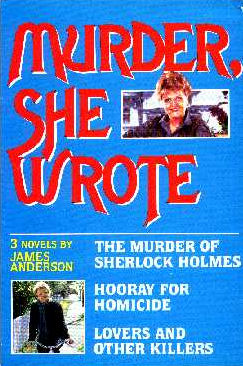
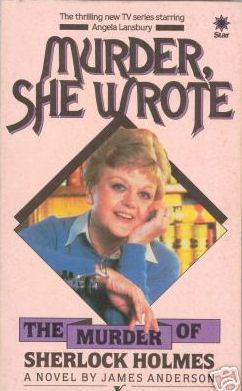
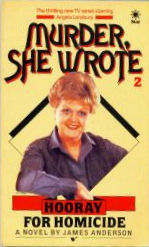
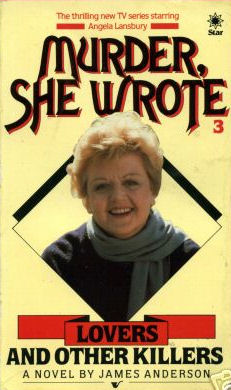 Murder, She Wrote by James Anderson – the book pictured is the hardcover collection of James Anderson’s three Murder, She Wrote novels, which first appeared in 1985. The books, The Murder of Sherlock Holmes, Hooray for Homicide, and Lovers and Other Killers were novelizations of some of the earliest episodes of the series. For the most part, Mr. Anderson is faithful to the plots of those episodes, though he does occasionally stray at critical moments. Case in point, he changes the setting of the climactic scene in The Murder of Sherlock Holmes, moving it inside. Somehow, that scene loses a good deal of its punch without the pool.
Murder, She Wrote by James Anderson – the book pictured is the hardcover collection of James Anderson’s three Murder, She Wrote novels, which first appeared in 1985. The books, The Murder of Sherlock Holmes, Hooray for Homicide, and Lovers and Other Killers were novelizations of some of the earliest episodes of the series. For the most part, Mr. Anderson is faithful to the plots of those episodes, though he does occasionally stray at critical moments. Case in point, he changes the setting of the climactic scene in The Murder of Sherlock Holmes, moving it inside. Somehow, that scene loses a good deal of its punch without the pool.
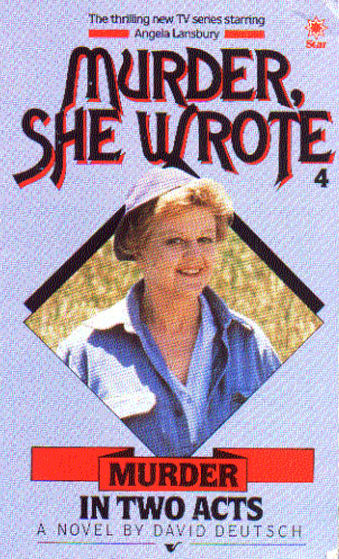 Murder in Two Acts by David Deutsch – Very, very rare! Meant to be the continuation of the James Anderson books, this fourth book by David Deutsch was published only in Great Britain, and is virtually unknown in the United States. A novelization of the episodes “Sing a Song of Murder” and “Murder in the Afternoon” from the second season, the author’s zeal comes through in extreme faithfulness to the scripts and an elevation of Jessica’s talents to almost supernatural status. Read it if you can find it.
Murder in Two Acts by David Deutsch – Very, very rare! Meant to be the continuation of the James Anderson books, this fourth book by David Deutsch was published only in Great Britain, and is virtually unknown in the United States. A novelization of the episodes “Sing a Song of Murder” and “Murder in the Afternoon” from the second season, the author’s zeal comes through in extreme faithfulness to the scripts and an elevation of Jessica’s talents to almost supernatural status. Read it if you can find it.
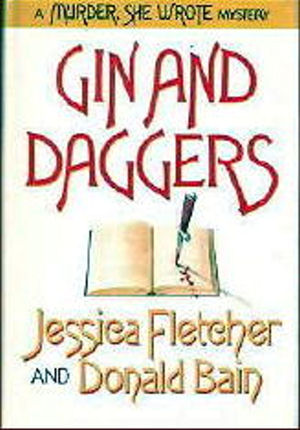 Gin and Daggers (first edition) by Donald Bain - When Gin and Daggers first appeared in 1989, it was the first MSW book of any sort that had appeared since the short-lived Anderson series four years earlier. Unlike the Anderson books, this book is written in first person, in Jessica’s voice. I am a little uncomfortable with the notion of a man writing in a woman’s voice. One of Angela Lansbury’s complaints during Murder, She Wrote’s run was that Jessica, created by male writers, often thought like a man. This book, if anything, amplifies the concept.
Gin and Daggers (first edition) by Donald Bain - When Gin and Daggers first appeared in 1989, it was the first MSW book of any sort that had appeared since the short-lived Anderson series four years earlier. Unlike the Anderson books, this book is written in first person, in Jessica’s voice. I am a little uncomfortable with the notion of a man writing in a woman’s voice. One of Angela Lansbury’s complaints during Murder, She Wrote’s run was that Jessica, created by male writers, often thought like a man. This book, if anything, amplifies the concept.
I hate to quibble, but I do wish that Mr. Bain had watched a few more episodes of MSW before sitting down at the word processor. Although he has the character of Jessica down pretty well, and Seth more or less correct, his characterization of Mort Metzger is frustratingly way off the mark. He consistently writes for Mort as though Mort were Amos Tupper. But by far the greatest sin he commits in this novel is the faux pas of having Jessica drive a car – a flagrant violation of one of the most basic tenants of the series. Why the editors didn’t catch this I have no idea.
This being said, the continuity issues weren't entirely his fault. According to Mr. Bain's recently published autobiography Murder, He Wrote, when he embarked upon this enterprise he requested character sheets on all the main characters, and was told no such things existed (!). The complete lack of direction from the Powers That Be at Universal made it difficult for him not to make errors of this nature. Mr. Bain's grasp of the canon subsequently improved over the course of the book series.

 Manhattans and Murder by Donald Bain – After disappearing for a time following the publication of the fatally flawed Gin and Daggers, Donald Bain returns with the second first book of his MSW series. It’s a good story, set in New York City at Christmastime as Jessica, visiting her publisher and his wife, tries to track down a former Cabot Cove resident she bumped into on the street. Particularly enjoyable are the chapters where Jessica, now a material witness to a murder, slips the leash of the NYPD and ducks home to Maine to do some more background investigating of her own.
Manhattans and Murder by Donald Bain – After disappearing for a time following the publication of the fatally flawed Gin and Daggers, Donald Bain returns with the second first book of his MSW series. It’s a good story, set in New York City at Christmastime as Jessica, visiting her publisher and his wife, tries to track down a former Cabot Cove resident she bumped into on the street. Particularly enjoyable are the chapters where Jessica, now a material witness to a murder, slips the leash of the NYPD and ducks home to Maine to do some more background investigating of her own.
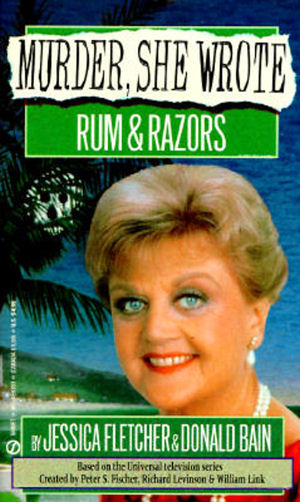 Rum and Razors by Donald Bain – You know what the definition of 'irony' is? It's when an author pens a scene in which a bookseller critiques Jessica's choice of a straight razor as a murder weapon in one of her books as too gruesome and violent, and then uses a straight razor as the murder weapon in the main plot of the same book.
Rum and Razors by Donald Bain – You know what the definition of 'irony' is? It's when an author pens a scene in which a bookseller critiques Jessica's choice of a straight razor as a murder weapon in one of her books as too gruesome and violent, and then uses a straight razor as the murder weapon in the main plot of the same book.
St. Thomas in the U.S. Virgin Islands is the backdrop for this, the third book in the Donald Bain Murder, She Wrote series. I feel so sorry for Jessica - she is so looking forward to a vacation on St. Thomas after a winter spent battling pneumonia, but when she gets there the island that looked so postcard-perfect from the window of the airplane turns out to be inhabited by some very angry people on the ground. It is a characteristic of the earlier books in the MSW series that the characters are highly emotive, and often mercurial, sometimes to the point of bewildering the reader with their unpredictability. Characters who seem anxious to talk with Jessica one moment close down and become hostile to her presence the next, often for no discernible reason. If the aim is to make the reader feel Jessica's frustration then it succeeds, but that isn't necessarily a good thing in terms of smoothly advancing the plot.
Still, despite these hiccups of character moodiness, the book does manage to unwind like an episode of the series, and the setting of St. Thomas is a very pleasant one for the plot to inhabit. Seth appears about two-thirds of the way through the story - its obvious to the reader that he's there to keep an eye on and/or protect Jessica, but because this is told from her point of view this is never admitted to in so many words. Jessica does have to drag him along to get him to help her on her adventures, but his reluctance is entirely in character and fortunately never solidifies into actual plot-stalling hindrance.
There are some big loose ends in this book. The biggest one I can't mention because it would be a spoiler for the plot, but it does hang out there like a big matzah ball. As for the other bits of plot left flailing, I was hoping that some of these at least would be tied up in a final wrap-up chapter, but that chapter never appeared. Some of the tidying-up is carried out by way of what I would consider needless character death. Nevertheless, despite these minor points this is still a solid entry in the series for such an early book.
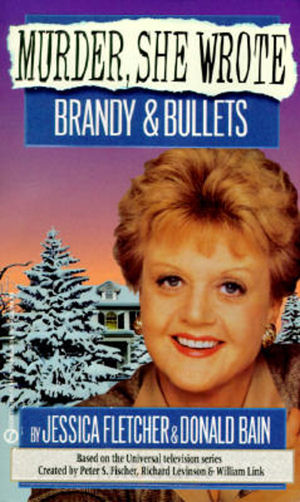 Brandy and Bullets by Donald Bain – Donald Bain’s first attempt at portraying Cabot Cove is only moderately successful. The response of the townspeople to the establishment of an arts institute outside of the village is met with unnecessary hostility and ignorance that is neither flattering nor realistic. The scene with the hypnotist in Boston is pretty good, though.
Brandy and Bullets by Donald Bain – Donald Bain’s first attempt at portraying Cabot Cove is only moderately successful. The response of the townspeople to the establishment of an arts institute outside of the village is met with unnecessary hostility and ignorance that is neither flattering nor realistic. The scene with the hypnotist in Boston is pretty good, though.
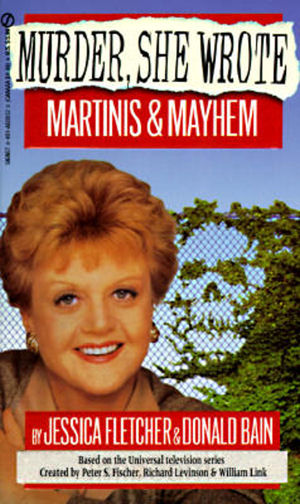 Martinis and Mayhem by Donald Bain – Ignore the murder plot, and you’ve got a pretty good book. The fourth novel in the Donald Bain series is set in San Francisco, and makes good use of the setting – but I found myself completely uninterested in the main plotline concerning Jessica’s attempts to prove innocent a woman wrongly imprisoned for murder, and the ending was a bit of a farce. Far more interesting and better handled was the subplot, in which George Sutherland, also in San Francisco for a police conference, continues to court the hesitant Jessica. Read those bits and skip the rest.
Martinis and Mayhem by Donald Bain – Ignore the murder plot, and you’ve got a pretty good book. The fourth novel in the Donald Bain series is set in San Francisco, and makes good use of the setting – but I found myself completely uninterested in the main plotline concerning Jessica’s attempts to prove innocent a woman wrongly imprisoned for murder, and the ending was a bit of a farce. Far more interesting and better handled was the subplot, in which George Sutherland, also in San Francisco for a police conference, continues to court the hesitant Jessica. Read those bits and skip the rest.
 A Deadly Judgment by Donald Bain – An interesting book that follows Jessica to Boston for an extended stay as a jury consultant in a murder case. Anyone who has been to Boston will enjoy picking out familiar landmarks. Mr. Bain again uses what is by now becoming a familiar device – bringing Seth in toward the end of the book for no other apparent reason than to keep an eye on Jessica.
A Deadly Judgment by Donald Bain – An interesting book that follows Jessica to Boston for an extended stay as a jury consultant in a murder case. Anyone who has been to Boston will enjoy picking out familiar landmarks. Mr. Bain again uses what is by now becoming a familiar device – bringing Seth in toward the end of the book for no other apparent reason than to keep an eye on Jessica.
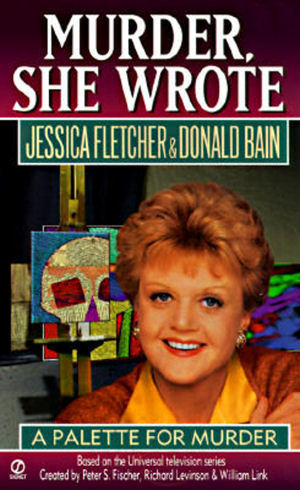 A Palette for Murder by Donald Bain – This book follows Jessica out to an artist colony on Long Island, looking for a chance to work in some other creative medium than writing. As usual, not much creating goes on because she quickly finds herself preoccupied by a murder. It’s good, one of the better books of the series – but what’s with this D thing, Donald? It’s JB Fletcher, not JD.
A Palette for Murder by Donald Bain – This book follows Jessica out to an artist colony on Long Island, looking for a chance to work in some other creative medium than writing. As usual, not much creating goes on because she quickly finds herself preoccupied by a murder. It’s good, one of the better books of the series – but what’s with this D thing, Donald? It’s JB Fletcher, not JD.
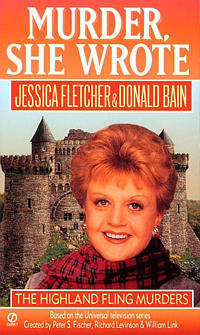 The Highland Fling Murders by Donald Bain – Possibly the best book to date by Mr. Bain. The murder case is gripping, the characters are interesting, and you can’t beat the subplot as George and Jessica pick up where they left off in Martinis and Murder. Touching, yes, but at the same time I found myself shaking my head as I watched Mr. Bain work himself into a dilemma that can have no good outcome without flying directly in the face of the most sacred tenants of the Murder, She Wrote canon. He seems to have realized this; this particular subplot virtually disappears after this book and remains, to this day, unresolved. Still, this is an excellent offering, and my favorite Donald Bain so far.
The Highland Fling Murders by Donald Bain – Possibly the best book to date by Mr. Bain. The murder case is gripping, the characters are interesting, and you can’t beat the subplot as George and Jessica pick up where they left off in Martinis and Murder. Touching, yes, but at the same time I found myself shaking my head as I watched Mr. Bain work himself into a dilemma that can have no good outcome without flying directly in the face of the most sacred tenants of the Murder, She Wrote canon. He seems to have realized this; this particular subplot virtually disappears after this book and remains, to this day, unresolved. Still, this is an excellent offering, and my favorite Donald Bain so far.
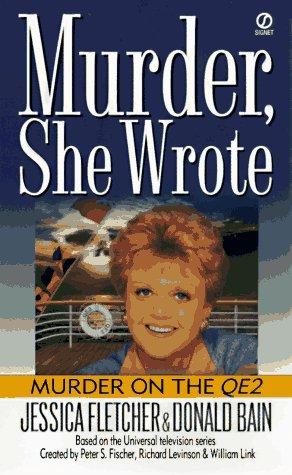 Murder on the QEII by Donald Bain – This novel is okay, I guess, but I found that I liked the teaser for it that appeared at the end of Highland Fling Murders better than the actual book itself. That teaser was totally gone by the time the actual book was published, victim of an apparently extensive and transforming rewrite; I rather wish he’d left it in.
Murder on the QEII by Donald Bain – This novel is okay, I guess, but I found that I liked the teaser for it that appeared at the end of Highland Fling Murders better than the actual book itself. That teaser was totally gone by the time the actual book was published, victim of an apparently extensive and transforming rewrite; I rather wish he’d left it in.
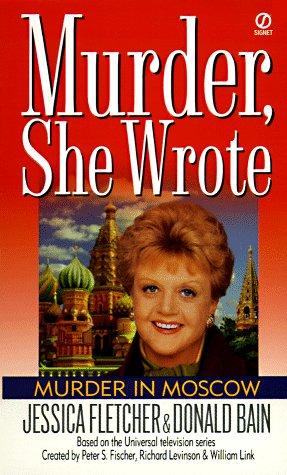 Murder in Moscow by Donald Bain – If Highland Fling Murders was Donald Bain’s best book, this one was the worst. An incomprehensible murder plot culminates in a ridiculous (and overlong) chase scene, then peters out with no definitive conclusion. A Murder, She Wrote story in which the murderer remains uncaught? Unthinkable. But then, the whole premise of this book required a significant stretch of the imagination anyway. I was extremely disappointed by this one.
Murder in Moscow by Donald Bain – If Highland Fling Murders was Donald Bain’s best book, this one was the worst. An incomprehensible murder plot culminates in a ridiculous (and overlong) chase scene, then peters out with no definitive conclusion. A Murder, She Wrote story in which the murderer remains uncaught? Unthinkable. But then, the whole premise of this book required a significant stretch of the imagination anyway. I was extremely disappointed by this one.
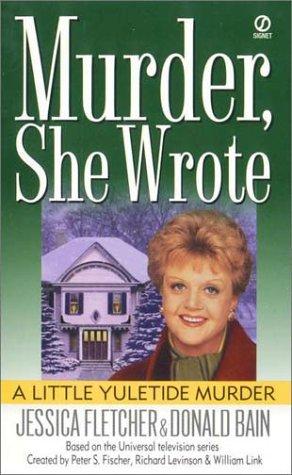 A Little Yuletide Murder by Donald Bain – The plot is slower than molasses in December, but somehow you don’t mind. This is Donald Bain’s second novel in the series to be set in Cabot Cove, and this time he has a much better grip on the local colour. The first half of the book drags, but the reader is so beguiled reading about the details of Jessica’s normal life in the Maine coast village that you don’t notice that whole chapters are going by without the case moving anywhere.
A Little Yuletide Murder by Donald Bain – The plot is slower than molasses in December, but somehow you don’t mind. This is Donald Bain’s second novel in the series to be set in Cabot Cove, and this time he has a much better grip on the local colour. The first half of the book drags, but the reader is so beguiled reading about the details of Jessica’s normal life in the Maine coast village that you don’t notice that whole chapters are going by without the case moving anywhere.
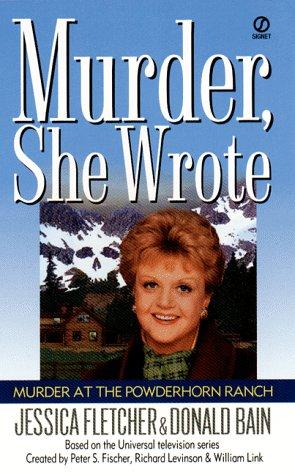 Murder at the Powderhorn Ranch by Donald Bain – Seth riding a horse? Jessica flying a Cessna? Okaaaaaay ... In this offering from Donald Bain, the characters really step out a little during a vacation to a ranch in Colorado. He also capitalizes on Seth’s protective tendencies toward Jessica, more pronounced in this book than in previous stories, as well as Jessica’s gentle resistance of his well-meant hovering. Though these new elements take shape in this book, the reader will also come upon plot elements that seem awfully familiar – which they are, because he’s used them in previous books.
Murder at the Powderhorn Ranch by Donald Bain – Seth riding a horse? Jessica flying a Cessna? Okaaaaaay ... In this offering from Donald Bain, the characters really step out a little during a vacation to a ranch in Colorado. He also capitalizes on Seth’s protective tendencies toward Jessica, more pronounced in this book than in previous stories, as well as Jessica’s gentle resistance of his well-meant hovering. Though these new elements take shape in this book, the reader will also come upon plot elements that seem awfully familiar – which they are, because he’s used them in previous books.
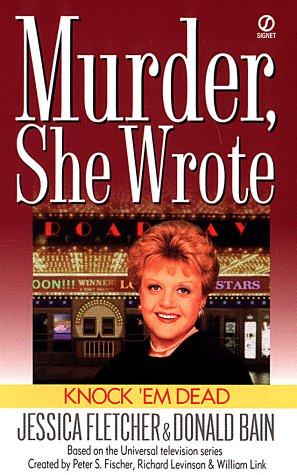 Knock ‘Em Dead by Donald Bain - This is a good book, one of the better ones in the Donald Bain series. The story’s good - a nice, tight, logical plot, which has not always been the case in Mr. Bain's works. He peoples the theater where most of the story takes place with volatile characters, but not so many that the reader becomes lost in the tangle of egos. The action moves along nicely. Now, the downside: my main problem is (again) with his characterization of Mort Metzger, a character he clearly is unfamiliar with from the show. Mort gets all nervous and overprotective about Jessica going to New York City, brings up a number of Big Apple stereotypes, and in general acts as if he's never been there - which, of course, he has. As anyone who watches the series knows, he spent most of his life in New York before coming to Cabot Cove. Mr. Bain seems unaware of this.
Knock ‘Em Dead by Donald Bain - This is a good book, one of the better ones in the Donald Bain series. The story’s good - a nice, tight, logical plot, which has not always been the case in Mr. Bain's works. He peoples the theater where most of the story takes place with volatile characters, but not so many that the reader becomes lost in the tangle of egos. The action moves along nicely. Now, the downside: my main problem is (again) with his characterization of Mort Metzger, a character he clearly is unfamiliar with from the show. Mort gets all nervous and overprotective about Jessica going to New York City, brings up a number of Big Apple stereotypes, and in general acts as if he's never been there - which, of course, he has. As anyone who watches the series knows, he spent most of his life in New York before coming to Cabot Cove. Mr. Bain seems unaware of this.
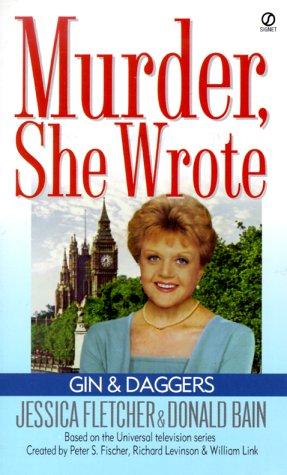 Gin and Daggers (second edition) by Donald Bain – After a long absence in the realm of Out of Print, Donald Bain dusts off his first book in the MSW series, the one that was more or less disowned because of glaring continuity and character flaws. He corrects the most obvious error – Jessica driving a car – but the rest of the book is exactly the same as the first edition, he didn’t change a thing. Still, it’s a good read, and for anyone who missed Gin and Daggers during its first brief incarnation, it’s necessary to understand where the character of George Sutherland, who plays such an important role in later books, came from.
Gin and Daggers (second edition) by Donald Bain – After a long absence in the realm of Out of Print, Donald Bain dusts off his first book in the MSW series, the one that was more or less disowned because of glaring continuity and character flaws. He corrects the most obvious error – Jessica driving a car – but the rest of the book is exactly the same as the first edition, he didn’t change a thing. Still, it’s a good read, and for anyone who missed Gin and Daggers during its first brief incarnation, it’s necessary to understand where the character of George Sutherland, who plays such an important role in later books, came from.
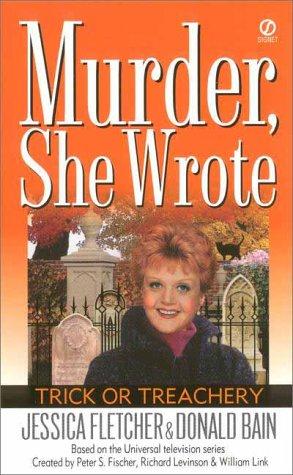 Trick or Treachery by Donald Bain - This Halloween-themed installment in the Donald Bain series returns to Cabot Cove for its setting after a long absence. At the heart of the plot is a self-proclaimed medium claiming to be able to make contact with the spirit world, and the accusations that fly to and fro begin to shed a new light on a suspected arson-related death in the recent past. While this book does have its moments, many of the supporting characters are so obstinately two-dimensional that the reader grows increasingly frustrated with them. Also unconvincing is Mr. Bain's attempt to fill in some of the early history of Cabot Cove. His claim that the town was founded by Winfred and Hepzibah "The Legend" Cabot is an unnecessary historical inaccuracy - any student of New England history knows that English sea captain John Cabot explored the Maine coast, and it is for him that the town is named.
Trick or Treachery by Donald Bain - This Halloween-themed installment in the Donald Bain series returns to Cabot Cove for its setting after a long absence. At the heart of the plot is a self-proclaimed medium claiming to be able to make contact with the spirit world, and the accusations that fly to and fro begin to shed a new light on a suspected arson-related death in the recent past. While this book does have its moments, many of the supporting characters are so obstinately two-dimensional that the reader grows increasingly frustrated with them. Also unconvincing is Mr. Bain's attempt to fill in some of the early history of Cabot Cove. His claim that the town was founded by Winfred and Hepzibah "The Legend" Cabot is an unnecessary historical inaccuracy - any student of New England history knows that English sea captain John Cabot explored the Maine coast, and it is for him that the town is named.
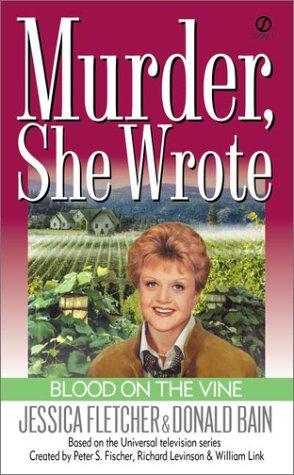 Blood on the Vine by Donald Bain - Jessica's in Napa Valley, visiting with friends from Cabot Cove, taking a between-books vacation with George Sutherland and gathering a little information on wine making for her next opus. The murder of a successful but odious vintner takes center stage when his spineless son begs Jessica to help uncover his killer. The real mystery here, however, is why Jessica, for the flimsiest of reasons, would sacrifice her vacation with old friends to go stay in the insufferable company of the most pathetic bunch of losers ever to grace the printed page. Vivid descriptions of California wine country and a couple of zingers toward the end of the book are high points. Fans wondering where Mr. Bain was going with the whole Jessica/George courtship thing and how he was going to wriggle out of it without killing off one of them get their answer here - sort of.
Blood on the Vine by Donald Bain - Jessica's in Napa Valley, visiting with friends from Cabot Cove, taking a between-books vacation with George Sutherland and gathering a little information on wine making for her next opus. The murder of a successful but odious vintner takes center stage when his spineless son begs Jessica to help uncover his killer. The real mystery here, however, is why Jessica, for the flimsiest of reasons, would sacrifice her vacation with old friends to go stay in the insufferable company of the most pathetic bunch of losers ever to grace the printed page. Vivid descriptions of California wine country and a couple of zingers toward the end of the book are high points. Fans wondering where Mr. Bain was going with the whole Jessica/George courtship thing and how he was going to wriggle out of it without killing off one of them get their answer here - sort of.
 Murder in a Minor Key by Donald Bain - This book is so rich in its descriptions of New Orleans that it takes you to the Big Easy without a plane ticket. Add some colourful characters and a plot composed of several complexly interwoven threads, and you get a great story, one of the best I've encountered yet in the Donald Bain series. The genteel world of the organized book tour, a raucous jazz festival, and traditional voodoo (treated in a refreshingly non-Hollywood typecast sort of way) are all on a collison course with Jessica at the epicenter, and the reader, I think, will like the results.
Murder in a Minor Key by Donald Bain - This book is so rich in its descriptions of New Orleans that it takes you to the Big Easy without a plane ticket. Add some colourful characters and a plot composed of several complexly interwoven threads, and you get a great story, one of the best I've encountered yet in the Donald Bain series. The genteel world of the organized book tour, a raucous jazz festival, and traditional voodoo (treated in a refreshingly non-Hollywood typecast sort of way) are all on a collison course with Jessica at the epicenter, and the reader, I think, will like the results.
 Provence - To Die For by Donald Bain - Ever notice that when authors set books in popular tourist destinations, it's almost always when the weather's beautiful and the scenery is postcard perfect? Here's an interesting twist - Donald Bain takes us to the South of France in the off season. It's a tactic that grants the reader a different view of the region, and helps focus the story on the colourful cast of year-round locals. The first part of the book meanders until Jessica finds a firm reason to pursue her investigations, but once that happens the story picks up steam in the second half and crescendos toward an unexpected ending.
Provence - To Die For by Donald Bain - Ever notice that when authors set books in popular tourist destinations, it's almost always when the weather's beautiful and the scenery is postcard perfect? Here's an interesting twist - Donald Bain takes us to the South of France in the off season. It's a tactic that grants the reader a different view of the region, and helps focus the story on the colourful cast of year-round locals. The first part of the book meanders until Jessica finds a firm reason to pursue her investigations, but once that happens the story picks up steam in the second half and crescendos toward an unexpected ending.
 You Bet Your Life by Donald Bain - If you’re looking for tips on how to play the slots or shoot craps in this Las Vegas outing, you’ll be disappointed. But if you like courtroom drama and law tactics, sit down and prepare for a fast read. With its plot revolving around the mechanics of a criminal jury trial (complete with commentary from cable television’s very own Court TV), You Bet Your Life represents something of a departure from Donald Bain’s usual style. After a beginning that sets the stage with flashbacks, the book soon settles down into a good read that’s half murder mystery and half law thriller. In contrast with the last several Murder, She Wrote books which depended heavily on location to help establish atmosphere, this book, centered in the courtroom, could have been set anywhere. However, over the course of the trial the characters evolve into such a diverse and colourful population that they outshine even the bright lights of the Las Vegas setting.
You Bet Your Life by Donald Bain - If you’re looking for tips on how to play the slots or shoot craps in this Las Vegas outing, you’ll be disappointed. But if you like courtroom drama and law tactics, sit down and prepare for a fast read. With its plot revolving around the mechanics of a criminal jury trial (complete with commentary from cable television’s very own Court TV), You Bet Your Life represents something of a departure from Donald Bain’s usual style. After a beginning that sets the stage with flashbacks, the book soon settles down into a good read that’s half murder mystery and half law thriller. In contrast with the last several Murder, She Wrote books which depended heavily on location to help establish atmosphere, this book, centered in the courtroom, could have been set anywhere. However, over the course of the trial the characters evolve into such a diverse and colourful population that they outshine even the bright lights of the Las Vegas setting.
 Majoring in Murder by Donald Bain - Majoring in Murder sweeps readers off their feet right from the get-go - literally. Before the end of the first chapter a tornado touches down on the Indiana campus of Schoolman College, where Jessica is guest-lecturing, leaving in its wake wrecked buildings and lives. But the destruction caused by the storm turns out to be nothing compared to the disruption stirred up by Jessica as she sifts through the college community's buried secrets to reach the truth behind a professor's "accidental" death. Although some of the characters in this book are basic stock (the cocky, too-smart-for-his-own-good undergrad, the devoted but underappreciacted secretary), others prove to be multifaceted, with complex personalities lurking behind their public facades. For Jessica this proves to be a boon in some cases, but a grave disappointment in others - proving that people, like books, can't always be judged by their covers.
Majoring in Murder by Donald Bain - Majoring in Murder sweeps readers off their feet right from the get-go - literally. Before the end of the first chapter a tornado touches down on the Indiana campus of Schoolman College, where Jessica is guest-lecturing, leaving in its wake wrecked buildings and lives. But the destruction caused by the storm turns out to be nothing compared to the disruption stirred up by Jessica as she sifts through the college community's buried secrets to reach the truth behind a professor's "accidental" death. Although some of the characters in this book are basic stock (the cocky, too-smart-for-his-own-good undergrad, the devoted but underappreciacted secretary), others prove to be multifaceted, with complex personalities lurking behind their public facades. For Jessica this proves to be a boon in some cases, but a grave disappointment in others - proving that people, like books, can't always be judged by their covers.
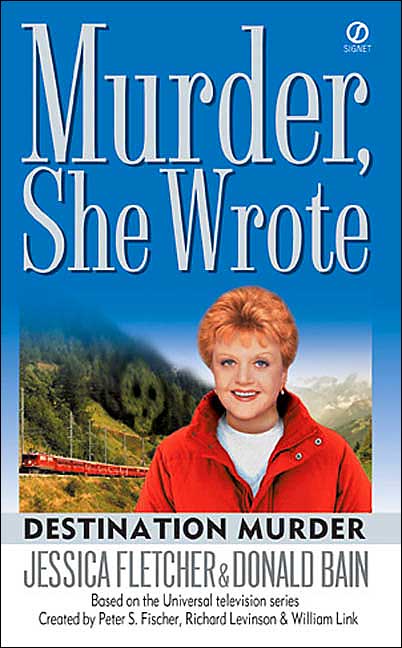 Destination Murder by Donald Bain - In British Columbia, Canada, for a scenic train trip at the invitation of a friend, Jessica finds herself stuck for three days in the close confines of a passenger train car with some of the ... how shall I put this ...more colorful members of a model train fan club. Mr. Bain fills the train with a variety of well-characterized individuals, who all share two things in common: they love trains, and they're all annoying to spend any length of time around. Each has their own more-or-less odious personality traits, from the wife of the club president (she's a word that starts with "b" and rhymes with "witch") to the jerk from England who doesn't have a kind word to say about anyone except himself. The reader can sympathize with poor Jessica as she tries to find rare moments of peace away from these people. In fact, sometimes the reader needs some peace away from them as well ... a desire that is best served by putting the book down for awhile and walking away.
Destination Murder by Donald Bain - In British Columbia, Canada, for a scenic train trip at the invitation of a friend, Jessica finds herself stuck for three days in the close confines of a passenger train car with some of the ... how shall I put this ...more colorful members of a model train fan club. Mr. Bain fills the train with a variety of well-characterized individuals, who all share two things in common: they love trains, and they're all annoying to spend any length of time around. Each has their own more-or-less odious personality traits, from the wife of the club president (she's a word that starts with "b" and rhymes with "witch") to the jerk from England who doesn't have a kind word to say about anyone except himself. The reader can sympathize with poor Jessica as she tries to find rare moments of peace away from these people. In fact, sometimes the reader needs some peace away from them as well ... a desire that is best served by putting the book down for awhile and walking away.
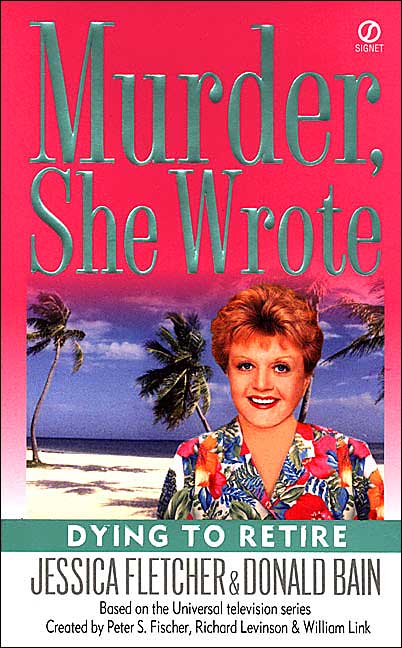 Dying to Retire by Donald Bain - When it's winter in Maine, there's nothing better than reading about places that are warmer than ... Maine in winter. Dying to Retire provides just such an opportunity - or rather, two opportunities, as the venue switches from a retirement community in southeast Florida to Key West and back again. The retirement community, quaintly named Foreverglades, is populated with a likable bunch of senior citizens, while the inhabitants of Key West are interesting in a quirky sort of way. Not every character is who they appear to be - although most of them are. The best parts of the book are the chapters that take place in Key West, which is described in luscious tropical detail.
Dying to Retire by Donald Bain - When it's winter in Maine, there's nothing better than reading about places that are warmer than ... Maine in winter. Dying to Retire provides just such an opportunity - or rather, two opportunities, as the venue switches from a retirement community in southeast Florida to Key West and back again. The retirement community, quaintly named Foreverglades, is populated with a likable bunch of senior citizens, while the inhabitants of Key West are interesting in a quirky sort of way. Not every character is who they appear to be - although most of them are. The best parts of the book are the chapters that take place in Key West, which is described in luscious tropical detail.
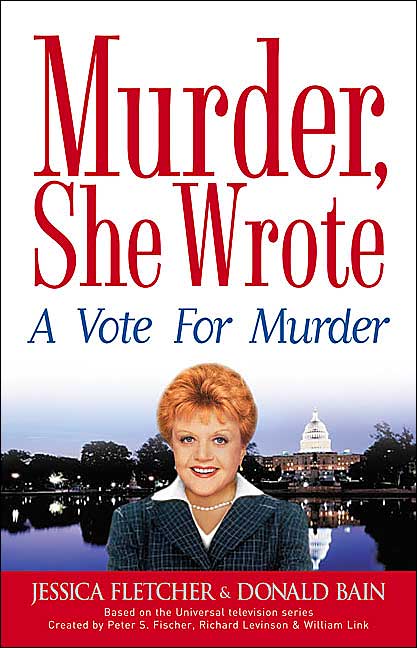 A Vote for Murder by Donald Bain - I've got to admit, the plot for this book was pretty gosh darn twisty plot, which made for a very fast and interesting read. And the book's setting in Washington, D.C. is spectacular, although I could wish that we got the chance to visit more places of import than we do. Those are the big upsides for this book. The downsides are that despite having Jessica, Seth Hazlitt, and George Sutherland all in the same city, George and later Seth pretty much get relegated to set decoration/sidekick duty. As for the rest of the book, it was populated by the usual gang of unsympathetic characters that really seem to deserve each others' company. My final complaint: too many loose ends left at the end of the book. A lot of the issues (issues that contributed so much to the deliciously twisty plot I mentioned) just never get the chance to resolve. I love the way the book ends (very sweet), but was left yearning for an epilogue just to tie things up.
A Vote for Murder by Donald Bain - I've got to admit, the plot for this book was pretty gosh darn twisty plot, which made for a very fast and interesting read. And the book's setting in Washington, D.C. is spectacular, although I could wish that we got the chance to visit more places of import than we do. Those are the big upsides for this book. The downsides are that despite having Jessica, Seth Hazlitt, and George Sutherland all in the same city, George and later Seth pretty much get relegated to set decoration/sidekick duty. As for the rest of the book, it was populated by the usual gang of unsympathetic characters that really seem to deserve each others' company. My final complaint: too many loose ends left at the end of the book. A lot of the issues (issues that contributed so much to the deliciously twisty plot I mentioned) just never get the chance to resolve. I love the way the book ends (very sweet), but was left yearning for an epilogue just to tie things up.
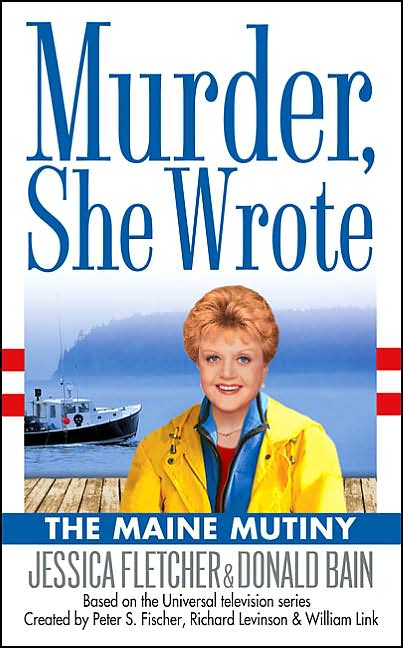 The Maine Mutiny by Donald Bain - A bad situation is rapidly getting much, much worse ... and that's just the prologue. The Maine Mutiny takes no prisoners - it plunges the reader right into the midst of its story with all the breathtaking shock of a leap into a cold lake. How exactly we get to this point is then the subject of a rapid and engaging read. I really enjoyed this book, and one big reason is that it rings true. Mr. Bain certainly did his homework for this one; his descriptions of lobstering and the lobster industry are detailed and accurate (as the wife of a lobsterman I can claim some authority to back up this statement). This one's a page turner, and is by far the most realistic representation of coastal Maine of any of the books in the Murder, She Wrote series.
The Maine Mutiny by Donald Bain - A bad situation is rapidly getting much, much worse ... and that's just the prologue. The Maine Mutiny takes no prisoners - it plunges the reader right into the midst of its story with all the breathtaking shock of a leap into a cold lake. How exactly we get to this point is then the subject of a rapid and engaging read. I really enjoyed this book, and one big reason is that it rings true. Mr. Bain certainly did his homework for this one; his descriptions of lobstering and the lobster industry are detailed and accurate (as the wife of a lobsterman I can claim some authority to back up this statement). This one's a page turner, and is by far the most realistic representation of coastal Maine of any of the books in the Murder, She Wrote series.
 Margaritas and Murder by Donald Bain - Of all the books Donald Bain has written, this was the first one that I literally couldn't put down. Instead, I read the whole thing, start to finish, in the space of four hours. I was not enthusiastic about the premise of this story at the beginning, sensing a set-up that was ripe for stereotyping and predictable plotlines, but was very pleasantly surprised - the stereotypes are kept to a bare minimum, and the plot moves along at a fast clip without losing the reader's interest. Also engaging was the subtle subplot that is deftly interwoven with the main plot before the ending. Earning my further admiration are the deliberate and accurate nods to established MSW canon and continuity - always important points on my scorecard. Set aside a block of time for this one - you may find, as I did, that once you start reading, you won't be able to set it aside.
Margaritas and Murder by Donald Bain - Of all the books Donald Bain has written, this was the first one that I literally couldn't put down. Instead, I read the whole thing, start to finish, in the space of four hours. I was not enthusiastic about the premise of this story at the beginning, sensing a set-up that was ripe for stereotyping and predictable plotlines, but was very pleasantly surprised - the stereotypes are kept to a bare minimum, and the plot moves along at a fast clip without losing the reader's interest. Also engaging was the subtle subplot that is deftly interwoven with the main plot before the ending. Earning my further admiration are the deliberate and accurate nods to established MSW canon and continuity - always important points on my scorecard. Set aside a block of time for this one - you may find, as I did, that once you start reading, you won't be able to set it aside.
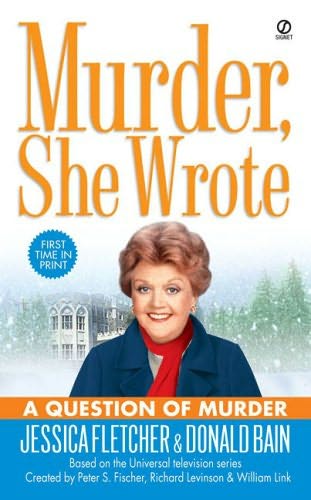 A Question of Murder by Donald Bain - It's a mystery within a mystery: at a mystery theater weekend in the Berkshires, a real murder occurs even as participants are busy unraveling the onstage murder they came to see. It's a great concept, made all the more intriguing to readers by the addition of a question about the mystery genre at the start of every chapter (don't worry, the answers are in the back - and yes, Mr. Bain is aware that the provided answer to Chapter 3's question is wrong). Unfortunately, the book is too short to adequately handle the complicated plot. Certain bits of information are provided by overly simplistic means, many characters do not get the opportunity to grow into well-roundedness, and the murderer's confessional soliloquy, meant to tie up the (numerous) loose ends, is improbably long and flowery. It would be interesting to see what this book could be if its plot, and characters, were freed from the limitations of time, location, and page count.
A Question of Murder by Donald Bain - It's a mystery within a mystery: at a mystery theater weekend in the Berkshires, a real murder occurs even as participants are busy unraveling the onstage murder they came to see. It's a great concept, made all the more intriguing to readers by the addition of a question about the mystery genre at the start of every chapter (don't worry, the answers are in the back - and yes, Mr. Bain is aware that the provided answer to Chapter 3's question is wrong). Unfortunately, the book is too short to adequately handle the complicated plot. Certain bits of information are provided by overly simplistic means, many characters do not get the opportunity to grow into well-roundedness, and the murderer's confessional soliloquy, meant to tie up the (numerous) loose ends, is improbably long and flowery. It would be interesting to see what this book could be if its plot, and characters, were freed from the limitations of time, location, and page count.
 Three Strikes and You're Dead by Donald Bain - Another engaging read that I devoured in one day, Three Strikes visits the world of minor league baseball, and does an excellent job of illustrating life on the farm teams. Here's a hint: it's not nearly as glamorous as the Major Leagues, but every bit as political. The story pulls the reader along at a steady pace, and does a good job of creating a minor league team whose players are distinctive and true-to-form. Occasional nods to the Red Sox were also pleasing, at least to this long-suffering fan (yes, we won the World Series in '04 and '07, but we're still suffering, okay?).
Three Strikes and You're Dead by Donald Bain - Another engaging read that I devoured in one day, Three Strikes visits the world of minor league baseball, and does an excellent job of illustrating life on the farm teams. Here's a hint: it's not nearly as glamorous as the Major Leagues, but every bit as political. The story pulls the reader along at a steady pace, and does a good job of creating a minor league team whose players are distinctive and true-to-form. Occasional nods to the Red Sox were also pleasing, at least to this long-suffering fan (yes, we won the World Series in '04 and '07, but we're still suffering, okay?).
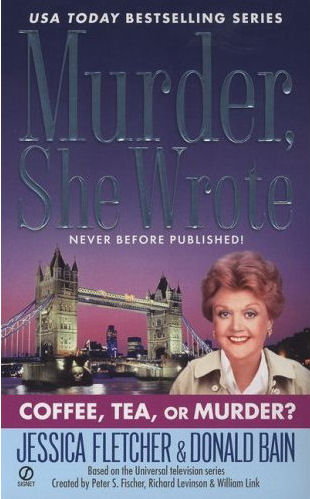 Coffee, Tea, or Murder? by Donald Bain - If you're an ardent fan of the series and felt like something was missing in this book, it's not just you. Many readers sensed the same thing. I am referring, of course, to the B-plot of the book, the continuation of Jessica's relationship with George Sutherland. When the release date of this book was announced, Donald Bain hinted that it would see an uptick in the status of that relationship, something many readers were looking forward to. Alas, the results were disappointing. This was through no fault of Mr. Bain's - rather, the blame lies with his overseers at MCA/Universal, the folks that legally own the rights to Jessica's character, who apparently didn't approve of what they saw and sliced and diced the B-plot to ribbons. Mr. Bain describes what happened on the discussion page of his website: "Now, for the budding romance between Jessica and George Sutherland. I keep trying to advance that relationship, but MCA-Universal, which owns the Jessica Fletcher character, wields a fast and vicious blue pencil on those scenes. The latest book, COFFEE, TEA OR MURDER?, is a good example. I created myriad scenes between Jessica and George, many of which had to be toned down in the final manuscript. ... I'm not sure where the future will take the relationship, but we'll see. ... I do feel, as you do, that they go to extremes, and my editor at NAL shared my disappointment that certain scenes in COFFEE, TEA OR MURDER? had to be cut or edited. But along with being a writer, I also pride myself in understanding the "business" aspect of publishing. My deal is to write the best possible books within the structure of the contracts I sign. In other words, I understand and respect the terms of the deal, and I try to pick my fights. Aside from their penchant for applying too heavy an editorial hand on occasion, the folks at MCA are a pleasure to work with. Bummer that. We'll never know what was in those "myriad scenes," and wagers made as to whether or not they'd share a kiss must remain forever unsettled.
Coffee, Tea, or Murder? by Donald Bain - If you're an ardent fan of the series and felt like something was missing in this book, it's not just you. Many readers sensed the same thing. I am referring, of course, to the B-plot of the book, the continuation of Jessica's relationship with George Sutherland. When the release date of this book was announced, Donald Bain hinted that it would see an uptick in the status of that relationship, something many readers were looking forward to. Alas, the results were disappointing. This was through no fault of Mr. Bain's - rather, the blame lies with his overseers at MCA/Universal, the folks that legally own the rights to Jessica's character, who apparently didn't approve of what they saw and sliced and diced the B-plot to ribbons. Mr. Bain describes what happened on the discussion page of his website: "Now, for the budding romance between Jessica and George Sutherland. I keep trying to advance that relationship, but MCA-Universal, which owns the Jessica Fletcher character, wields a fast and vicious blue pencil on those scenes. The latest book, COFFEE, TEA OR MURDER?, is a good example. I created myriad scenes between Jessica and George, many of which had to be toned down in the final manuscript. ... I'm not sure where the future will take the relationship, but we'll see. ... I do feel, as you do, that they go to extremes, and my editor at NAL shared my disappointment that certain scenes in COFFEE, TEA OR MURDER? had to be cut or edited. But along with being a writer, I also pride myself in understanding the "business" aspect of publishing. My deal is to write the best possible books within the structure of the contracts I sign. In other words, I understand and respect the terms of the deal, and I try to pick my fights. Aside from their penchant for applying too heavy an editorial hand on occasion, the folks at MCA are a pleasure to work with. Bummer that. We'll never know what was in those "myriad scenes," and wagers made as to whether or not they'd share a kiss must remain forever unsettled.
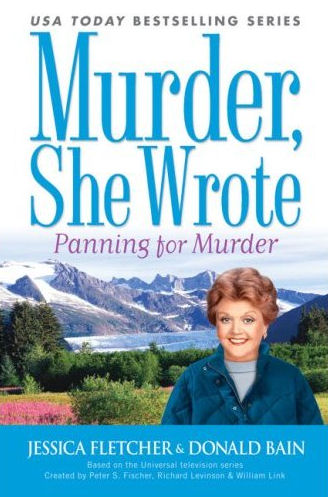 Panning for Murder by Donald Bain - What a coincidence: Jessica has booked a cruise to Alaska for herself just weeks after the sister of one of her friends, on a mission to track down an ancestor's stash of gold nuggets, vanishes into the Alaskan bush. The friend, Kathy, knows an opportunity when she sees one and invites herself along for the trip, turning Jessica's anticipated vacation into more of a working holiday (which, when you think about it, is pretty much par for the course for her). I've read other books that start out this way, with the Uninvited Companion usually becoming the Annoying Sidekick in short order. In this case, however, Mr. Bain pulls off a remarkable feat: the down-to-earth character of Kathy manages to remain realistic and likable with only occasional lapses into annoyance. She is a character that I would not mind reading about again.
Panning for Murder by Donald Bain - What a coincidence: Jessica has booked a cruise to Alaska for herself just weeks after the sister of one of her friends, on a mission to track down an ancestor's stash of gold nuggets, vanishes into the Alaskan bush. The friend, Kathy, knows an opportunity when she sees one and invites herself along for the trip, turning Jessica's anticipated vacation into more of a working holiday (which, when you think about it, is pretty much par for the course for her). I've read other books that start out this way, with the Uninvited Companion usually becoming the Annoying Sidekick in short order. In this case, however, Mr. Bain pulls off a remarkable feat: the down-to-earth character of Kathy manages to remain realistic and likable with only occasional lapses into annoyance. She is a character that I would not mind reading about again.
As was true for A Question of Murder, there is a longer book inside of Panning that didn't have room to get written (not Mr. Bain's fault, I should note - the publisher sets page limits on his manuscrips). Several interesting characters and situations arise in the course of the story that do not get the page time they deserve or are left dangling as loose ends at the conclusion of the book. There's an epilogue of sorts, but it didn't address all of the questions I was left with when it was over. Perhaps someday Mr. Bain will be allowed to write lengthier books? That would certainly please a great many fans.
 Murder on Parade by Donald Bain - It's a story as old as Vacationland itself: despite overwhelming odds, plucky local townsfolk manage to hold back the relentless tide of progress as defined by aggressive, wealthy developers From Away, thus preserving their threatened way of life for another day. It's a plot that's been retold several times in various Cabot Cove MSW episodes, and it's the theme of Donald Bain's latest book, also set in Cabot Cove, Murder on Parade. Given that the formula of townspeople-v.-developers has been done so many times, there was a danger that this latest retelling of that familiar plot would come across as stale. Happily, this was not the case. Although I occasionally grew weary of hearing about how hot it was in Cabot Cove that July, the strong cast of characters, both new and recurring, kept this story fresh all the way to its blockbuster-style ending.
Murder on Parade by Donald Bain - It's a story as old as Vacationland itself: despite overwhelming odds, plucky local townsfolk manage to hold back the relentless tide of progress as defined by aggressive, wealthy developers From Away, thus preserving their threatened way of life for another day. It's a plot that's been retold several times in various Cabot Cove MSW episodes, and it's the theme of Donald Bain's latest book, also set in Cabot Cove, Murder on Parade. Given that the formula of townspeople-v.-developers has been done so many times, there was a danger that this latest retelling of that familiar plot would come across as stale. Happily, this was not the case. Although I occasionally grew weary of hearing about how hot it was in Cabot Cove that July, the strong cast of characters, both new and recurring, kept this story fresh all the way to its blockbuster-style ending.
One of those characters, as foretold by Mr. Bain on his website, was Amos Tupper, back in Maine for a visit. Although I was a little disappointed (and surprised) that Amos didn't get more "page time," it was good to see him back in his continuity-correct form. Kathy Copeland, the break-out character from last fall's Panning for Murder also makes a repeat appearance along with her sister, at least for the first half of the book (they disappear completely after that). But my far my favorite new kid on the block is Jessica's friend and former FBI agent Rick Allcott, a surprisingly nuanced character that adds a dimension of complexity to the plot in spite of his seemingly mild manner. It's this cast of characters that keeps this oft-told tale new, even if its moral - "What price progress?" - is as old as the coast of Maine itself.
 A Slaying in Savannah by Donald Bain - Pre-publication hype surrounding this book touted it as being possibly the strongest offering yet in Mr. Bain's MSW series, which is quite a statement to make considering the longevity of the franchise. I am pleased to report that my reading of A Slaying in Savannah has left me with the same positive impression: if you must pick one book to read of the thirty novels Mr. Bain has written in Jessica's voice, you would do well to make it this one. Longer than previous novels, this story sees an ambivalent Jessica heading to historic (and haunted) Savannah, Georgia to try her hand at solving a forty-year-old cold case at the behest of her recently deceased friend Tillie. As Jessica attempts to piece together the facts surrounding the old murder plots of a decidedly more contemporary nature swirl around her, lending a sense of urgency to the proceedings despite the relative vintage of the crime at their heart.
A Slaying in Savannah by Donald Bain - Pre-publication hype surrounding this book touted it as being possibly the strongest offering yet in Mr. Bain's MSW series, which is quite a statement to make considering the longevity of the franchise. I am pleased to report that my reading of A Slaying in Savannah has left me with the same positive impression: if you must pick one book to read of the thirty novels Mr. Bain has written in Jessica's voice, you would do well to make it this one. Longer than previous novels, this story sees an ambivalent Jessica heading to historic (and haunted) Savannah, Georgia to try her hand at solving a forty-year-old cold case at the behest of her recently deceased friend Tillie. As Jessica attempts to piece together the facts surrounding the old murder plots of a decidedly more contemporary nature swirl around her, lending a sense of urgency to the proceedings despite the relative vintage of the crime at their heart.
As in previous books, the setting itself takes on a life of its own, whether it be Tillie's beloved Mortelaine House with its decaying gothic decor or the lush green of Savannah at St. Patrick's Day. If I had a complaint (and I have very few), it might be that occasionally the descriptions run overlong, becoming less a sense of setting and more a travel guide, but overall the environments enhance the story far more than they detract from it. Also, there are a few loose ends left unresolved at the end of the book that I would like to have had some closure on. Leaving those points aside, good dialogue and brisk, consistent pacing make this a breezy read and leave the reader feeling like they just watched an all-too-short episode of the original series instead of finishing a novel.
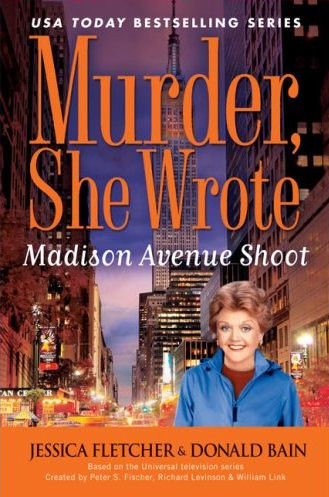 Madison Avenue Shoot by Donald Bain - Before I get down to the business of reviewing this book, the continuity stickler in me would like to make the following statement: Donna Fletcher was in the waning weeks of her pregnancy with Frank during the book-end episode "The Szechuan Dragon," which aired at the end of Season 6 ... in the spring of 1990. So strictly speaking, if we assume that Madison Avenue Shoot is set in the present day (i.e., 2009) - which, based on all the pop culture references, it would have to be - then by series-reckoning Frank would be eighteen years old by this point, not nine.
Madison Avenue Shoot by Donald Bain - Before I get down to the business of reviewing this book, the continuity stickler in me would like to make the following statement: Donna Fletcher was in the waning weeks of her pregnancy with Frank during the book-end episode "The Szechuan Dragon," which aired at the end of Season 6 ... in the spring of 1990. So strictly speaking, if we assume that Madison Avenue Shoot is set in the present day (i.e., 2009) - which, based on all the pop culture references, it would have to be - then by series-reckoning Frank would be eighteen years old by this point, not nine.
Okay, now that we have that out of the way, I can once again retreat to the pleasant (and, in the case of the Murder, She Wrote franchise, entirely necessary) alternate reality where Jessica, her friends, and her family never age and can continue having adventures indefinitely into the foreseeable future.
Madison Avenue Shoot's centerpiece is another much ballyhooed appearance by former regulars of the series on the printed page. Last spring, it was Amos Tupper who was making a triumphal return; this time, Jessica's trouble-prone nephew Grady, his wife Donna, and their son Frank have their turn. The trouble with these special guest appearances is that they're difficult to pull off the first time, and for characters with only a handful of series appearances to refer to, all the more so. I thought that Mr. Bain did a fairly good job with Grady - the at times questionable judgment, the boyish enthusiasm, the tendency to get ahead of himself. Donna, on the other hand, is barely recognizable. Part of the problem is that Debbie Zipp's portrayal of her was as much visual as it was anything else - that "deer-in-the-headlights" look that seemed to be Donna's trademark whether she was getting married or killing someone with a fish just doesn't translate well to the book. As for Frank ... well, at least he's a blank slate, one that Mr. Bain fills in pretty well, even if at times I was strongly reminded of the reasons why I have chosen to remain childless.
The chief problem with the book, as I see it, is that there are too many times when Frank's antics take over the story, to the detriment of the mystery. He's not the only culprit; the mechanics of shooting a television commercial also occupy the spotlight for an inordinate amount of time, especially in the first half of the book, meaning that it's a very long time (for a murder mystery) before anyone gets killed. While interesting, I found myself skimming whole sections dealing with these mechanics, hoping to get past them so I could get on with the story.
On the plus side, once the story does break free of Frank and the commercial-making process, Jessica does manage to do some excellent sleuthing that was very enjoyable to read, and her concern and love for Grady and his family is palpably real. Seth gets a cameo too, and it's one of his most authentic appearances to date, something that earns a well-deserved shout-out from the purist in me. I didn't really get the strong sense of place in this book that has been the hallmark of other books - we were in New York, right? - but I had to smile at the description of Jessica's first hotel room, and the meticulous detail given to the commercial-related locales more than carries the day as far as atmosphere is concerned. Although some of the people associated with the production company blended together at times, the rest of the of the assembled cast of characters were varied and interesting (and sometimes annoying), and they all had something to hide.
PS: Here's a piece of trivia for you: Michael Horton, who played Grady in the series, and Debbie Zipp, who played Donna, are married in real life. Neat, huh?
 A Fatal Feast by Donald Bain - The Jessica and George 'shippers are swooning over the release of this book, which - finally - sees them officially declared a couple. Even Mr. Bain has confirmed their status as such in comments on his discussion page. Jessica can use the term "close friends" all she wants, but she's only kidding herself. I like that - I like this deliberate blind spot she has about relationships (obviously - I use it a lot in my fan fiction), and I also like it if for no other reason that it keeps the censors at Universal at bay. And where exactly were the censors? Asleep at the switch, apparently, the red ink of their pens mingling with their drool to make a lovely rose color on the manuscript. It's difficult to understand how they could be so aggressive about editing Jessica and George's last get-together in Coffee, Tea, or Murder and then let so much slip by in this book. No matter; we're all just happy that they did, allowing Mr. Bain to advance their relationship in a mature, thoughtful, and thoroughly satisfying fashion.
A Fatal Feast by Donald Bain - The Jessica and George 'shippers are swooning over the release of this book, which - finally - sees them officially declared a couple. Even Mr. Bain has confirmed their status as such in comments on his discussion page. Jessica can use the term "close friends" all she wants, but she's only kidding herself. I like that - I like this deliberate blind spot she has about relationships (obviously - I use it a lot in my fan fiction), and I also like it if for no other reason that it keeps the censors at Universal at bay. And where exactly were the censors? Asleep at the switch, apparently, the red ink of their pens mingling with their drool to make a lovely rose color on the manuscript. It's difficult to understand how they could be so aggressive about editing Jessica and George's last get-together in Coffee, Tea, or Murder and then let so much slip by in this book. No matter; we're all just happy that they did, allowing Mr. Bain to advance their relationship in a mature, thoughtful, and thoroughly satisfying fashion.
The only problem with this - and I hesitate to call it a problem - is that the 'B' plot (the relationship) frequently overshadows the 'A' plot (the mystery). Or should I say mysteries? There are two, really, one involving a mysterious, antisocial stranger hanging around Cabot Cove and the other a series of menacing letters Jessica receives in the mail. The latter is a plot device recycled from an earlier book in the series - I won't say which one, lest I give the resolution away - and when I recognized this, I was ... annoyed. That's putting it mildly. Yes, the letters contributed to the overall atmosphere of anxiety hanging over the proceedings, but as soon as I realized what was going on - as any loyal reader of the series will, eventually - all the suspense fled from this particular aspect of the plot. Too many angst-ridden pages were dedicated to the letters, which I felt was not fair to the reader no matter how much atmosphere they were supposed to convey.
The rest of the 'A' plot, while well-crafted, took a long time to get rolling. A lot of time - the first half of the book, in fact - is spent in character development. It's good character development, though, and pays off handsomely in the end. A well-rounded cast populates the story, and it's pleasing to see very few of them described in hick-like terms. The quality of the Cabot Cove stories in the series is something that has definitely improved over time. The murder mystery may be shallow, but the richness of the setting and the progression of Jessica and George's relationship - significantly enhanced by Seth's commentary upon it - still makes for a book of great depth.
 Murder Never Takes a Holiday by Donald Bain - This is a compilation book of previously issued holiday-themed novels, Manhattans and Murder and A Little Yuletide Murder. But just because it's a re-issue is no reason not to enjoy the lovely cover artwork.
Murder Never Takes a Holiday by Donald Bain - This is a compilation book of previously issued holiday-themed novels, Manhattans and Murder and A Little Yuletide Murder. But just because it's a re-issue is no reason not to enjoy the lovely cover artwork.
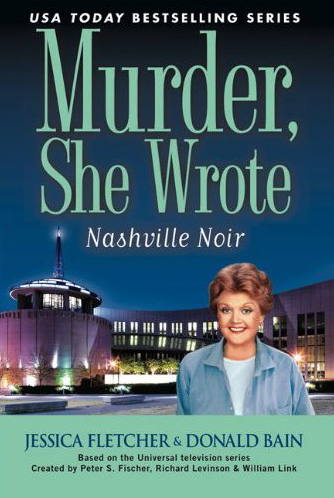 Nashville Noir by Donald Bain - I must admit that I felt a distinct lack of enthusiasm leading up to the release of this book. For one thing, country music, the centerpiece of the novel, is not my thing. Not at all. Not even a little bit. For another, this book had the misfortune of being sandwiched between two other titles drawing considerably more excitement from fans, 2009's A Fatal Feast (a very tough act to follow) and 2010's The Queen's Jewels.
Nashville Noir by Donald Bain - I must admit that I felt a distinct lack of enthusiasm leading up to the release of this book. For one thing, country music, the centerpiece of the novel, is not my thing. Not at all. Not even a little bit. For another, this book had the misfortune of being sandwiched between two other titles drawing considerably more excitement from fans, 2009's A Fatal Feast (a very tough act to follow) and 2010's The Queen's Jewels.
Despite having the deck stacked against it by this unfortunate conjunction of circumstances, Nashville Noir surprised me with its ability to quickly pull me into the story despite an ominously slow start in Chapter 1. I did not feel hit over the head with country music lyrics, something I'd been dreading ever since it was announced on Mr. Bain's website that David Stewart had written and recorded a song by the same name in honor of the book's release. (You can hear the song on Mr. Bain's homepage, if you are so inclined.) I did not have to skim large sections of chapters to escape the minutiae of how a country music song is produced. And I finished reading in two short nights, despite coming home from a tough week at work barely able to keep my eyes open. Far from the ho-hum read I had been expecting!
The book does have its weak points. It is well-grounded in its setting of Nashville, Tennessee - local flavor is something I have really come to look forward to and appreciate in Mr. Bain's novels - but still occasionally falls into the trap of sounding like a tour guide. Then there was the cast of characters - some were a bit more stereotypical than usual, but what really struck me was how unevenly they were treated. One supporting character/suspect received loads and loads of attention and page-time - it seemed like every time the reader turned the page, there he was. The other characters, by contrast, were dealt with relatively briefly. I would have liked to have seen some of the other suspects and their potential motives more fully developed, if only to balance out the perceived omnipresence of the afore-mentioned Ubiquitous Character.
In spite of these minor stumbles, Nashville Noir is well-able to hold its own. Especially pleasing and well-deserving of a Definitive Guide shout-out is the attention to canon: an accurate reference to Jessica's two previous visits to Nashville during the years of the original series. Kudos for that - and for providing a highly entertaining story anyone can enjoy, even someone who is not a fan of country music.
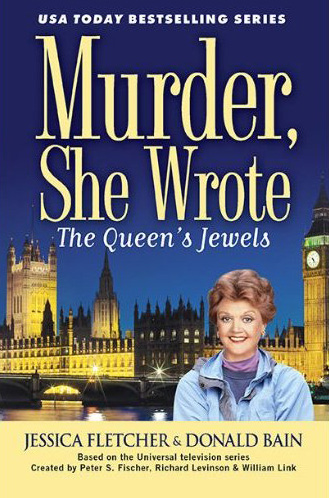 The Queen's Jewels by Donald Bain - Lots of two-word phrases come to mind in reaction to this book: "fast paced" is a good one; so are "continuity correct" and "ambitiously plotted." There's really only one negative two-word phrase that's applicable here: "too short."
The Queen's Jewels by Donald Bain - Lots of two-word phrases come to mind in reaction to this book: "fast paced" is a good one; so are "continuity correct" and "ambitiously plotted." There's really only one negative two-word phrase that's applicable here: "too short."
Die-hard fans of George Sutherland might also add the complaint of "not enough George," but that's a three-word phrase, not two. Not that it isn't true - even Jessica complains about his relative absence. But if she's lacking opportunities to spend time with him, part of the fault lies with her for budgeting too few days in London before heading to Southampton to board the Queen Mary II. Running on a schedule so tight it has her attending a formal dinner party the same night that she arrives in England? Madness. No wonder she thought she was seeing things when the evening's mystery guest turns out to be her old chum from MI6, the infamous Michael Haggerty.
Michael, another character from the original series making his first appearance on the printed page, is in his easily recognizable classic form, introducing himself with an alias and cocky Irish charm. Almost immediately he sets to work manipulating Jessica into assisting him in his efforts to get close to the principle suspects in the theft of the book's eponymous diamond. How convenient that they are all planning on sailing the Queen Mary II with her! Jessica's response to Michael's blatant maneuvers - exasperated yet gently firm refusal - is faithful to what we've seen on tv. So is Michael's response to Jessica's response, which is to essentially badger her until he gets his way. As Jessica's resistance wears down she has some lovely moments of introspection into her inexplicable attraction to real-life crime that makes for delightful reading.
In the lead-up to the release of The Queen's Jewels there was promise of another character from the series joining Michael in the jump from screen to book. I predicted that this would be Dennis Stanton, and I was right. It made sense: jewels, theft, insurance - who else could it be? Unfortunately Dennis doesn't make the transition quite as successfully as Michael does, in that he doesn't wholly come across as distinctly Dennis. This surprised me somewhat, as Dennis actually has more source material in the show than Michael does, including all of Season Seven's bookend episodes dedicated to no one but him. Yet there is not a single "Jessica, dearheart" or mention of his trademark umbrella cane sword to be found. It's not that he's unrecognizable - far from it. Other aspects of his character, from his mode of dress to his satiny charm, come through clearly. But if I were grading the results, I'd give the characterization of Dennis a B+ instead of an A.
The plot has layers and layers of intrigue, enough so that even if certain pieces of the puzzle fell into place fairly early on for me, the whole picture didn't coalesce until near the end. If the climax takes an almost self-congratulatory view of the plot, then I suppose the authors can be forgiven. I didn't like how Jessica consistently referred to Michael and Dennis as "Haggerty" and "Stanton" - she knows them both well enough that they would be "Michael" and "Dennis" to her - but this is a minor quibble and can also be forgiven. A subtle subplot involving a relatively minor character blossoms unexpectedly at the end of the book in a way that left me both touched and impressed.
Mr. Bain stated some time ago that one of the most popular books in the MSW series was Murder on the QEII. This current book, in my opinion, is much better, and if it tops QEII in popularity, it will well deserve its laurels.
 Skating on Thin Ice by Donald Bain - Let me say right from the get go: I enjoyed Skating on Thin Ice. It’s a smooth, pleasurable read. But other books in the series have inspired a kind of urgent suspense that has had me staying up late into the night to finish them, and that urgency was somehow missing this time around. There is a great quote from an episode of Iron Chef America: panelist Jeffrey Steingarten says to Chef Bobby Flay, "When you've really hit it, I can't stop eating. And I've stopped." Substitute “reading” for “eating,” and that pretty much sums up the situation.
Skating on Thin Ice by Donald Bain - Let me say right from the get go: I enjoyed Skating on Thin Ice. It’s a smooth, pleasurable read. But other books in the series have inspired a kind of urgent suspense that has had me staying up late into the night to finish them, and that urgency was somehow missing this time around. There is a great quote from an episode of Iron Chef America: panelist Jeffrey Steingarten says to Chef Bobby Flay, "When you've really hit it, I can't stop eating. And I've stopped." Substitute “reading” for “eating,” and that pretty much sums up the situation.
So what’s at issue here? It certainly isn’t a lack of interesting characters. To the contrary: there is a plethora of interesting characters, maybe even too many characters, as there doesn’t seem to be enough space in the book to flesh them all out. There is a core group of well-rounded characters around which the book revolves, but many others are introduced only to vanish for chapters and chapters (or in one case, for the rest of the book), while others fail to expand beyond the bounds of their archetypes. Sadly, even Eve Simpson, whose appearance in this book was eagerly awaited by fans, falls into this category, appearing only sporadically throughout the course of the story.
As for the plot: forgive me for the obvious pun, but the pace of the plot was glacial. Part of the problem was too much Cabot Cove chitchat - it pains me to say that, as I am an unabashed fan of Cabot Cove - and part of it was that the investigative methods were largely passive. Watching Jessica do a Google search, for instance: very plausible in this day and age, in which internet research is an infinitely faster and easier way to gather information than traditional gumshoe legwork, but also not terribly interesting to read about. There was very little hunting down of physical clues, and when there was, it was usually done with official sanction, which took away opportunities for Jessica to engage in creative (and, if the reader is lucky, dangerous) solo snooping.
Shortcomings aside, the book is, as I stated at the outset, a pleasurable read - like good comfort food on a rainy night. It may not be the award-winning gourmet lobster macaroni-and-cheese I saw on Throwdown tonight, but really, is there anything wrong with regular macaroni-and-cheese so long as it’s done well, and with love?
 The Fine Art of Murder by Donald Bain - This is a tale of two books. There’s the first half of the book (starts out with a little Italy, then takes place mainly in Chicago), and then there’s the second half of the book (takes place mainly in Italy, then finishes with a little more Chicago). I got the feeling that Mr. Bain wanted to set a book in Italy, and he wanted to set another book in Chicago - but he didn’t have quite enough material to make a go of both of them, so he melded them together into a whole. I’m probably mistaken in thinking that, but the difference in the quality of the story between the two locations is so striking that I can’t quite get that niggling suspicion out of my head.
The Fine Art of Murder by Donald Bain - This is a tale of two books. There’s the first half of the book (starts out with a little Italy, then takes place mainly in Chicago), and then there’s the second half of the book (takes place mainly in Italy, then finishes with a little more Chicago). I got the feeling that Mr. Bain wanted to set a book in Italy, and he wanted to set another book in Chicago - but he didn’t have quite enough material to make a go of both of them, so he melded them together into a whole. I’m probably mistaken in thinking that, but the difference in the quality of the story between the two locations is so striking that I can’t quite get that niggling suspicion out of my head.
The first part of the The Fine Art of Murder was not particularly promising. With few exceptions, the Chicago-based characters - including Jessica’s friend, whom she is ostensibly there to save - were some of the most unsympathetic and unlikable since Destination Murder and Blood on the Vine. Such characters may be colorful on the page, but they leave such a sour taste that you don’t really care what happens to them. Jessica’s lines of investigation meander and are occasionally interrupted by what I have come to call “travel logs,” descriptions of places and local history that are good for the setting but stall the plot. As a result, the first half of the story comes across as unevenly paced, lurching like a car with a manual transmission and a balky clutch. (Forgive me, I've been watching a lot of the BBC's Top Gear lately.)
Fortunately the book takes a turn for the better once Jessica meets art expert Anthony “Tony” Curso and returns to Italy in his company. Initially the description of Tony with his short stature and floppy bow ties made me worry that he was merely an Italian retread of Lucas Darling from Gin and Daggers, but this fear was unfounded. Tony is a well-developed character all of his own and easy to like. His presence opens doors for Jessica’s investigation - ordinarily I don’t like it when Jessica is “led” by outside agents, but in this case Tony is necessary for putting her in contact with resources she would not have had access to otherwise. Italy itself, exotically beautiful yet sullied by a little Mafia problem, makes for a far better backdrop than Chicago. Once back in Rome the pace and urgency of the plot pick up noticeably. Although the book must end back in dreary Chicago with its cast of dreary characters, at least we aren’t forced to go back there until near the end.
As for the ending itself, it’s very abrupt, almost like Mr. Bain was in a hurry to wrap it up. It hangs on the answer to the question, "What happened to the murder weapon?" Unfortunately, there are a hundred more likely answers to that question than the one he comes up with. The answer also ignores a key piece of evidence that would have been obvious to the police right from the get-go, but for the fact that then there would have been no mystery to solve. I won't spoil it - if you want to know what it is, click here.
 Trouble at High Tide by Donald Bain - You would think, after 264 episodes, four post-season movies, 36 novels, and many, many fan fictions, that everyone would have figured out by now that extending an invitation to the Angel of Death to be a guest under your roof is a bad idea. Apparently federal judge Tom Betterton didn't get that memo; he offers Jessica the use of a cottage on his Bermuda estate and she, tired from a long book tour and weary of mud season in Maine, accepts. Thus the stage is set for this, the 37th novel by Donald Bain in the Murder, She Wrote book series. As for Jessica, she needs to stop taking walks on beaches after dark. It didn't end well for her on St. Thomas way back in Rum and Razors, and it doesn't end well this time either.
Trouble at High Tide by Donald Bain - You would think, after 264 episodes, four post-season movies, 36 novels, and many, many fan fictions, that everyone would have figured out by now that extending an invitation to the Angel of Death to be a guest under your roof is a bad idea. Apparently federal judge Tom Betterton didn't get that memo; he offers Jessica the use of a cottage on his Bermuda estate and she, tired from a long book tour and weary of mud season in Maine, accepts. Thus the stage is set for this, the 37th novel by Donald Bain in the Murder, She Wrote book series. As for Jessica, she needs to stop taking walks on beaches after dark. It didn't end well for her on St. Thomas way back in Rum and Razors, and it doesn't end well this time either.
Speaking of Rum and Razors, there are several similarities between that book and Trouble at High Tide, at least in their premise: a friend invites Jessica to come visit their beautiful island retreat which turns out to be several shades short of Paradise once you factor in the political intrigue, the turf wars with the neighbors, and, of course, the dead body lying at the edge of the surf. My initial fear was that this book would turn out to be a retread of the earlier one, but fortunately my concerns were quickly allayed. Trouble at High Tide is a very different novel. There are the characters, for one thing: when we meet most of the principals in the first few chapters the air is so thick with snark that it looks like they will add up to another carton-full of nasty, unlikable bad eggs. However, once Jessica gets to know Judge Betterton’s family, friends, and neighbors in the course of her investigations, a surprising amount of humanity emerges in most of the characters. The spoiled son with anger issues is a genuinely talented artist with an eye for inner beauty. The obstructionist neighbor is a genial fellow with two bad knees and a friendly wife. The girlfriend angling to become wife number five has an untapped maternal side. They’re all a sum of plusses and minuses, just like in real life. High marks for the characters.
Then there's the plot, actually two plots interwoven with each other: the ongoing Jack the Ripper-style killings that have the entire island of Bermuda in a tizzy, and the murder of Judge Betterton’s niece, which causes its own more localized upset. The crimes are linked, naturally - just how closely remains a matter of conjecture until the end of the book. Unfortunately, one plot is resolved in a rather anti-climatic fashion despite an atmosphere of heavy foreboding provided by a violent storm breaking over the island at nightfall. The other is wrapped up in such a hurry that we only get to read about it after all is said and done. The fact that fan favorite George Sutherland is in Bermuda to lead the investigation personally makes it all the more curious that it gets treated with such short shrift in its resolution. High marks for plot complexity; not-so-high marks for the ending.
Still, I enjoyed this book immensely and finished it in less than a day. Jessica gets to do quite a bit of active investigating, following leads that sometimes pay off and sometimes don't. In previous reviews I’ve noted that Mr. Bain occasionally has a problem with slipping into travel book mode, but in Trouble at High Tide he’s done a better job at keeping the tour guide bits short enough to enhance the setting without swamping it. The result is a quick, enjoyable read that moves along at a brisk pace, the action interspersed with postcard-like descriptions of the spectacular island of Bermuda.
 Domestic Malice by Donald Bain - Domestic Malice is wholly absorbing - I finished it in less than a day - but it is not a comfortable book to read. This is true even if the topic of domestic violence has never touched your life or the life of anyone you know. And if it has, well ... be forewarned, this book’s gonna strike a nerve.
Domestic Malice by Donald Bain - Domestic Malice is wholly absorbing - I finished it in less than a day - but it is not a comfortable book to read. This is true even if the topic of domestic violence has never touched your life or the life of anyone you know. And if it has, well ... be forewarned, this book’s gonna strike a nerve.
The subject matter, by its very nature, guaranteed that this was going to be a much darker story than what fans are accustomed to seeing from either the Donald Bain novels or the original television series. Not that domestic violence wasn’t touched on in the original series - it was - but it never got the depth of treatment that it does here. Domestic Malice treats the topic knowledgeably and with sensitivity, and the immense amount of time the Bains put into research and consulting with experts is very much in evidence in its pages.
The first several chapters open with postings from a (fictitious) domestic violence survivors’ message board, and they are heart-wrenching to read. The excerpts help set the atmosphere of these chapters while indirectly drawing attention to the fact that this is a problem that is too often never spoken of outside of the anonymity of the internet. Although these chapter-heading posts made for sobering reading, I was surprised that the motif was not continued beyond the early part of the book. Even though the central character in the story was no longer posting herself, other messages - uplifting or otherwise - could have continued to head up chapters.
The book is divided into two parts: Part 1 deals with the murder and the initial investigation, and Part 2 largely revolves around the courtroom as the prime suspect stands trial. It really should have been divided into three parts. The first chapter of Part 2 is a lengthy digression focused on Cabot Cove’s annual Blueberry Festival that is discordant with the rest of the book and does little, if anything, to advance the plot. Was it necessary to inject a little levity into an otherwise serious story? Maybe. But if so it would have been better to have it stand alone as an “Interlude” than as the kick-off to Part 2 and its attendant change of venue to the trial.
What saves Domestic Malice from being a total downer is Harry McGraw, Jessica’s seedy - erm, I mean colorful - Boston PI friend from the original series. The parts of the book I enjoyed the most were all his, and his interactions with Jessica were true enough to the source material that I could hear Harry’s theme music in my head as I was reading. My only complaint is the same one I had in The Queen’s Jewels: Jessica and Harry are friends, and as such, she wouldn’t be recalling him as “McGraw” in her memoirs. (Also, there was one small continuity error - Harry McGraw came to Cabot Cove twice in his six MSW appearances and knew Mort, but he never met Seth. It’s a very minor, picky point - don’t mind me.)
In the end, it was the ending that bothered me the most. Since I can’t go into my reasons for that in this review without dropping major spoilers, I’ll explain my reasons for this here, and you can click or not click here as you see fit. Overall, though, this was a very powerful book with a plot that will pull you along at breakneck speed while raising awareness of a serious problem that exists in every community. It’s very different from the rest of the books in the MSW series, and I laud the Bains for having the courage to write it. One thing I can promise: you will not come away from it unaffected.
 Prescription for Murder by Donald Bain - It’s too bad that Margaret Truman’s Experiment in Murder (also written by Donald Bain) already had the title claimed, because this book, Prescription for Murder, deserves the title just as much. It is, in essence, a grand experiment, the thesis of which is: what would happen if Seth Hazlitt, usually the stick-in-the-mud naysayer in regard to Jessica’s adventures, took a page from her book and decided to investigate a murder himself?
Prescription for Murder by Donald Bain - It’s too bad that Margaret Truman’s Experiment in Murder (also written by Donald Bain) already had the title claimed, because this book, Prescription for Murder, deserves the title just as much. It is, in essence, a grand experiment, the thesis of which is: what would happen if Seth Hazlitt, usually the stick-in-the-mud naysayer in regard to Jessica’s adventures, took a page from her book and decided to investigate a murder himself?
It’s an interesting idea, one with a lot of merit. Seth definitely needs to live a little from time to time, or risk becoming fossilized into a typecast character. This is true whether we’re talking about the television series or the books. It’s a wonder that Jessica doesn’t get completely exasperated with his overprotectiveness to the point of telling him to lighten up, so it certainly doesn’t hurt for him to see things from her perspective for once, and he certainly gets to do so here.
I like the setting of this book, the Cuban-American subculture of Tampa. In particular, the descriptions of the food, although not central to the story, had me yearning for the meals we’d get from Five Brothers Grocery in Key West. (Corner of Southard and Grinnell Streets - great Cuban cafe con leche. And if you go on a Tuesday, be sure to get the ropa vieja lunch special - it’s like heaven in a styrofoam takeout container.) The world of medical research is also a good choice for background, with its darker sides of competing egos and corporate greed providing ready-made conflicts that would more than adequately propel the plot, even without the added complication of clandestine government interests. The tension caused by these combined elements is palpable, like a storm looming on the horizon - and yes, storms have contributions to make to this story as well.
There are, however, one or two problems. Although I can accept - even appreciate - what can be considered an OOC (Out Of Character) experience for Seth, I wish that it had not come at the cost of an equally OOC performance for Jessica. Usually upbeat and chipper, she comes across as uncharacteristically negative, committed to the investigation only by her sense of duty to Seth rather than her own intrinsic passion for justice. Her reluctance leaches off the page and, in my case at least, infected the reader - I felt no particular hurry to finish the book, as if her disinterest had become mine. I may also have been influenced by the repetitive nature of the interactions with the suspects, all of whom are fixated on the same question and all of whom more-or-less get the same answer. By the third interview I realized that it wasn’t a question of whether a character would ask Jessica or Seth if they knew how far the victim had gotten with his research into an Alzheimer’s cure, but how soon it would come up in the conversation. I also wish - this is a sentiment I have expressed before - that there were better ways to incorporate the setting more subtly than interrupting the plot with paragraphs of history and description presented en masse. In this case, it’s Ybor City, Tampa’s Latin district, which gets the Lonely Planet treatment. (The history and particulars of cigar-making are folded into the story much more successfully.) There is also the book’s climax - ample clues are provided such that most readers will see it coming chapters and chapters ahead of time, yet Jessica, usually so observant, completely fails to connect the dots, an unrealistic lapse to say the least.
In the end, though, this is Seth’s book. Stepping out of his comfort zone and into Jessica’s gives us glimpse of a side to him that we seldom get to see, and that gives his character some extra depth. In the aftermath of William Windom’s passing this last year, it is a very fitting tribute to the character he brought to life, and a welcome reminder that while we may have lost the actor, the character will always be with us.
 Close-Up on Murder by Donald Bain - Once upon a time, there was apparently a murder in Cabot Cove that Jessica didn't personally involve herself with investigating. Maybe she was out of town, I don't know. I was under the impression that all the murders in Cabot Cove conveniently happened when she was at home. Anyway - because Jessica wasn't on hand to uncover the truth a miscarriage of justice occurred, so she did the next best thing: she wrote a book about it. And for a long time that was all she had to do with this particular mystery ... until a Hollywood studio struck a deal to turn the book into a movie.
Close-Up on Murder by Donald Bain - Once upon a time, there was apparently a murder in Cabot Cove that Jessica didn't personally involve herself with investigating. Maybe she was out of town, I don't know. I was under the impression that all the murders in Cabot Cove conveniently happened when she was at home. Anyway - because Jessica wasn't on hand to uncover the truth a miscarriage of justice occurred, so she did the next best thing: she wrote a book about it. And for a long time that was all she had to do with this particular mystery ... until a Hollywood studio struck a deal to turn the book into a movie.
For reasons best known to its executives, the studio decided not to take a short hop up the coast of California to film in Mendocino, despite its established popularity as a stand-in for a certain small Maine town. Instead, they packed the whole production up and shipped it all the way across the continent so they could shoot their movie in the real thing, an expensive decision as well as a dangerous one since Cabot Cove is, well, Cabot Cove.
Thank goodness those movie execs made that fateful decision to risk filming in the Death Capital of Maine, because if they hadn't, we would have missed out on a really good story. For one thing, the past murder case gets folded into the current events in a way that doesn't feel forced or contrived. For another, Cabot Cove comes off very well in its portrayal with a nice mix of familiar book-verse characters (Mara, Jack and Tobe Wilson, Barnaby Longshoot) and authentic series-verse characters (Eve Simpson, Ideal Malloy and Loretta Spiegel, who is eminently recognizable, especially in the scene where she's doing Jessica's hair). Locations felt true to the series and didn't overwhelm the action taking place therein. I liked the chihuahua that Jessica temporarily cares for a lot - I can't help it. And finally, the murder happened by the end of Chapter 3 - that may seem like a minor point, but it isn't. Murder mysteries tend to drag when there's no body on the ground by the middle of the story, and if you don't believe me, I offer as evidence some of the lesser episodes from Seasons 11 and 12.
There are a few minor problems, such as the post-murder press conference that I wish Jessica had slipped out of much, much earlier - it went on and on, and threatened to stall the momentum that had just been established by the early murder in Chapter 3. There is also a tendency for certain expository passages - about Jessica's pilot license, for instance - to repeat from book to book. I suppose these passages are necessary for each book to be considered "stand-alone," but most of us are dedicated readers of the series, and to us they sound very cut-and-paste, and interrupt the flow of the story. I honestly think they should be jettisoned. Lastly, I have a quibble with a certain Chekhov's gun that occurs in one of the later chapters - I'm not going to spoil what that is in this review, but if you're interested and don't mind spoilers, you can click here, here and see what I'm talking about.
Overall, though, this was a very enjoyable book that will remind readers of their favorite series episodes set in Cabot Cove, far more interesting than if the movie studio had taken the easy way out and filmed in Mendocino instead. Although there's some interesting grist there - if they had flown Jessica out to consult on the story there instead of coming to her, would she have found Mendocino ... hauntingly familiar, somehow?
 Aloha Betrayed by Donald Bain - Hey ... I thought George was supposed to be in this book! Ah, well, it's probably for the best that he wasn't. He'll undoubtedly get more lines in Death of a Blue Blood when it gets released in the fall.
Aloha Betrayed by Donald Bain - Hey ... I thought George was supposed to be in this book! Ah, well, it's probably for the best that he wasn't. He'll undoubtedly get more lines in Death of a Blue Blood when it gets released in the fall.
The plot of Aloha Betrayed is taken straight from the headlines: the controversial construction of a solar telescope on top of a volcano held sacred by the locals. The controversy was real, as you can read in this news article, though a couple of years old by the time of the book's release. I was impressed that the Bains chose this to be the central conflict of the story when they could have just as easily written about yet another random development on yet another environmentally sensitive site - a story everyone has heard many times in many forms. The solar telescope angle made the book feel grounded and relevant, and not just another Murder, She Wrote/Magnum, PI crossover.
It's well-known that one of the major perks of being the authors of the MSW series is that the Bains get to visit the exotic locales they end up featuring in their books, and they seem to have fully immersed themselves when they went to Maui to do their research for Aloha Betrayed. The high level of detail goes well beyond the lush scenery to the food, the drinks, the culture, and even the language of the locals. Occasionally some of this information was imparted in a lecture-like fashion, but fortunately not too often. The description of the sunrise on a mountaintop in particular was absolutely breathtaking. Chapter headings consisting of phrases in Hawaiian and their English translations were a clever touch, hinting at what was to come while staying on-theme.
Now we come to the characters. Instead of George, Jessica's side-kick is retired Maui police detective Mike Kane. Mike's a good guy, and a good character, one of the more well-developed characters in the book. But he's almost too good - think the complete opposite of Thomas Magnum in everything but fashion sense - and too convenient as a conduit of information between Jessica and the police. His apparently unfettered access to the details of the official investigation (isn't he supposed to be retired?) and nearly limitless availability (isn't he supposed to be in charge of security at some hotel?) sometimes felt like short cuts in the plot, a default answer to any problem at hand.
As for the rest of the people in this book, they didn't benefit from quite as much character development as Mike. Some of them are straight out of central casting: the arrogant cowboy-esque developer, the handsome surfer dude, the shamanistic matriarch. I did like Bob and Elaine Lowell, the vacationing couple largely present for comic relief ("Oh, Bob!"). An interesting exception to the rule is Mala, the murder victim, who gets more depth and breadth than one would think possible for someone who is dead by the beginning of Chapter 3.
Mala brings up another issue with this Aloha Betrayed: loose ends, of which there are quite a few. There's a HUGE one involving her that is still left hanging at the end of book, and I can't quite figure out why it had to be that way. And there are others - I'll put them here on this separate page for those who don't want to be subjected to spoilers. Sure, life is often ambiguous, but books don't have to be. Too many dangling questions leaves me, as a reader, feeling vaguely disappointed.
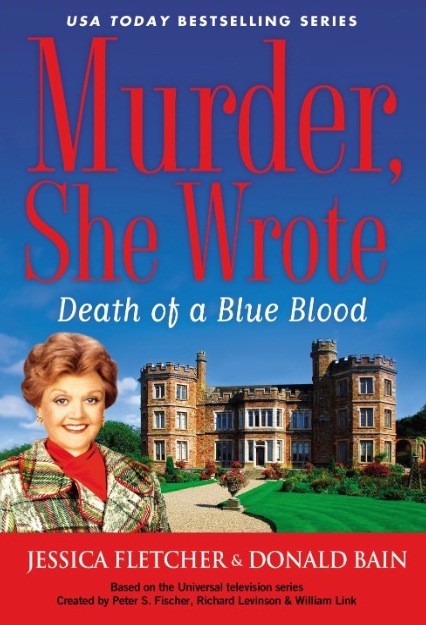 Death of a Blue Blood by Donald Bain - I guess I should begin by stating that the Downton Abbey phenomenon has passed me by. My heart is already given to a very different U.K. import, Top Gear. I have no desire to add another British tv show to my viewing schedule at the moment, and even if I did, it would probably be Inspector Morse, or possibly Doctor Who. I liked Matt Smith, but that Peter Capaldi fellow makes a pretty intriguing Time Lord.
Death of a Blue Blood by Donald Bain - I guess I should begin by stating that the Downton Abbey phenomenon has passed me by. My heart is already given to a very different U.K. import, Top Gear. I have no desire to add another British tv show to my viewing schedule at the moment, and even if I did, it would probably be Inspector Morse, or possibly Doctor Who. I liked Matt Smith, but that Peter Capaldi fellow makes a pretty intriguing Time Lord.
My eclectic taste in British programming aside, sources tell me that after four seasons and a staggering number of prominent character deaths, Downton remains a popular and apparently influential show. Donald and Renee Bain have quite openly cited it as the inspiration for Death of a Blue Blood, the forty-second MSW book. Fortunately, you don’t have to be a Downton follower to appreciate this story.
Tolstoy famously said, ”Happy families are all alike; every unhappy family is unhappy in its own way.” I don’t think this is necessarily the case in mystery fiction, especially if the family in question is prominent in terms of wealth or reputation. The Grants of Castorbrook Castle fulfill a number of literary tropes: the doomed patriarch, the disappointing heirs, the impatient social-climbing daughter-in-law. We’ve seen these archetypes before in MSW-land - specifically, I am strongly reminded of another aristocratic British family, the dysfunctional Constables from the Season Four episode “It Runs in the Family.” (Come to think of it, the Grants are also reminiscent of the obnoxious Ladington clan from an earlier MSW book, Blood on the Vine.) So when Lord Norrance dies in a spectacular display of conspicuous consumption and good timing, it’s fairly easy to match Motive A to Character B, at least among the surviving members of the family.
The commoners are a more varied group. The castle’s servants range from being fiercely loyal to so lightly affiliated that they scarcely rate any notice in the investigation at all. The townsfolk and invited guests also display a variety of ties to the castle and family, from the incidental and innocent to the intimate and suspect. Taken all together, there are plenty of motives to go around, and lots of perspectives for Jessica to collect in the course of her casual interviews.
The book is drenched in atmosphere: all that research the Bains did on Highclere Castle, the filming location for Downton Abbey, really pays off. Furthermore, the wintertime setting is a dramatic and apt reflection of the castle’s inhabitants, many of whom - family members and employees alike - are cited for their cold and hostile behavior. The warmth in the story comes from Jessica and George’s not-quite-relationship in spite of George’s curiously out-of-character behavior in the first half of the book. He’s a bit “off,” like a slightly out-of-tune violin string, not using his credentials in some situations where he should, and then asserting his authority in other situations where he probably shouldn’t. Most jarring of all, he brushes aside Jessica’s suspicions about the first death. By now he should know her well enough to never, ever doubt her instincts, particularly when there’s a dead body on the ground. It leads to a certain amount of tension between them, and it’s not the sort of tension the ‘shippers are looking for. Fortunately George regains his footing in time for the New Year’s Eve ball, and remains in good form for the rest of the book.
Death of a Blue Blood is truly a book designed to appeal to an overlapping readership. Murder, She Wrote fans will love it, of course, and as for fans of Downton ... well, I think they’ll find that it’s right up their abbey.
 A Killer in the Kitchen by Donald Bain - As any astute viewer of the Food Network knows, the restaurant business is full of drama. Restaurants have it all: long hours, financial riskiness, egos, rivalries, and, just to spice things up, the proximity of multiple sharp instruments. More than one episode of Murder, She Wrote took place in a restaurant setting, and it’s easy to see why.
A Killer in the Kitchen by Donald Bain - As any astute viewer of the Food Network knows, the restaurant business is full of drama. Restaurants have it all: long hours, financial riskiness, egos, rivalries, and, just to spice things up, the proximity of multiple sharp instruments. More than one episode of Murder, She Wrote took place in a restaurant setting, and it’s easy to see why.
Killer in the Kitchen capitalizes on all of these elements as it rolls along at a fast clip. The book pulls no punches, opening with a short vignette of the scene of the murder (without identifying the victim) that establishes a palpable sense of foreboding right from the outset. Although it becomes obvious fairly early in the running who the victim and chief suspect will be, there are enough possible candidates in the extensive cast of characters to keep an element of doubt running until the plot catches up with that opening flash-forward. Afterwards, there are more than enough suspects with complex backstories to go around. The plot is further enhanced by a extra doses of intrigue (possible organized crime connections) and sentiment (Jessica’s memory of and loyalty to an old friend). The descriptions of the rival restaurants and their fare were vivid and rich, but not overwhelming or distracting. The only part of the plot that requires any strenuous suspension of disbelief is the remarkable coincidence that an arrogant chef Jessica had a passing encounter with in New York City just happens to have a summer home in Cabot Cove, of all places.
There are, however, one or two problems.
The competitive, almost adversarial relationship between Jessica and Mort Metzger was a big issue for me. Besides not being faithful to the close friendship and collaborative working relationship portrayed in the series, it means that Jessica - and by extension, we, the readers - don’t get much in the way of first-hand clues. We never get to see the murder weapon. Jessica never sets foot in the scene of the crime. A lot of the front-line investigating happens off the page, which is not particularly fair to the reader in a “fair play” mystery. I noticed the same problem of Jessica and Mort being at loggerheads in A Fatal Feast and Domestic Malice - it was frustrating in those books, and it’s frustrating now.
The other problem with Killer in the Kitchen was the ending, which was, shall we say, abrupt. Let me explain: if you read on a Kindle or use a Kindle app, you always know exactly how far into a book you are because it displays a percentage of how much has been read down in the bottom right hand corner of the screen. Well, I knew something was amiss when I got to 98% and the solution to the mystery still had not been revealed. The identity of the the murderer, although it didn’t exactly come out of nowhere, did come only after an extremely last-minute, game-changing revelation, and with only 2% of the book left the denouement, a condensed second-hand summary of the confession and its aftermath, felt rushed.
These critiques aside, this was an enjoyable, fast-paced read with a high degree of emotional depth not seen since Domestic Malice. Everybody knows that the episodes of MSW set in Cabot Cove were the best; it would seem that this is proving true for the books as well.
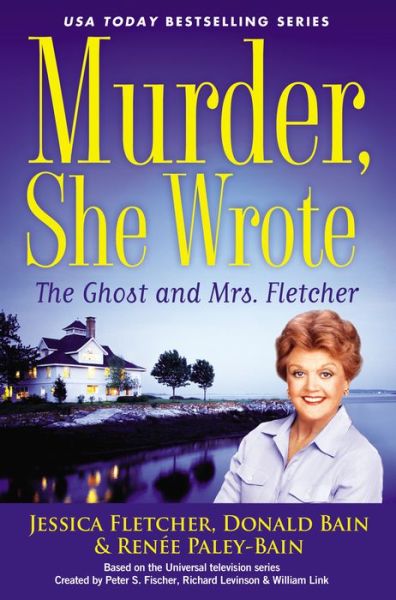 The Ghost and Mrs. Fletcher by Donald Bain - Back-to-back books set in Cabot Cove? Yes, please! I know not all readers of the MSW book series feel as I do - many people prefer book settings that take place away from Jessica’s homicide-plagued home town, and I can certainly understand their preference. But for those of us who do like the Cabot Cove “episodes” best, The Ghost and Mrs. Fletcher, following hard on the heels of last spring’s A Killer in the Kitchen, was a gift from the gods.
The Ghost and Mrs. Fletcher by Donald Bain - Back-to-back books set in Cabot Cove? Yes, please! I know not all readers of the MSW book series feel as I do - many people prefer book settings that take place away from Jessica’s homicide-plagued home town, and I can certainly understand their preference. But for those of us who do like the Cabot Cove “episodes” best, The Ghost and Mrs. Fletcher, following hard on the heels of last spring’s A Killer in the Kitchen, was a gift from the gods.
With Cliff Cooper dead by the beginning of chapter 2, the book swiftly dives into the conflicts that defined his life. Cliff raised his grandson from infancy - there’s a long story behind that, involving several people both living and dead, which is unraveled bit by bit over the course of the book. Well-paced, the plot breezily pulls the reader along without bogging down, making this book an easy one to read in one go. Many familiar faces from both the show and previous Cabot Cove-based novels make appearances, which lends a comfortable air of continuity. Even Cecil the Chihuahua from 2013’s Close-Up on Murder gets some page time. The portrayal of Eve Simpson is the best yet, particularly her take-no-prisoners approach to house selling, which leads to some over-the-top moments that fans of the show will recognize. And the shout-outs to some real-life Maine institutions (Moxie! MPBN! Amato’s!) always score points with me.
There are a few drawbacks. There isn’t much mystery about the mysterious handyman Eve hires to fix up the house for sale, although I will admit that I didn’t foresee the specific way that his plot point reached its end game. Motive is a little thin on the ground as well, though one could argue that characters in fiction have been killed for less.
Now bear with me for a moment while I go into full-on English major mode:
The best part of The Ghost and Mrs. Fletcher was ... that massive, eclectic collection of used books left behind by Cliff Cooper. Think about it: the book sale subplot, which runs through the story from near the beginning to the very end, is the perfect vehicle for the main plot. On a practical level, it is the ideal excuse for Jessica to spend lots of time exploring the inside of the Spencer Percy House, the scene of most of the action in the book. On a more fundamental level, the books become a stand-in of sorts for the man who collected them - an important point, since he's dead by the end of the first chapter. Sorting and boxing random books may not sound like the most exciting reading, but as the job progresses Jessica learns more about Cliff and some of the books actually seem to point to certain clues. Are these clues messages from Cliff? From the author of the books in question? The answer is left up to the imagination of the reader.
One final note: it’s nice to see Renee Paley-Bain finally getting her name on the front cover after all the years of collaboration with her husband on the series. It’s a well-deserved honor.
 Design for Murder by Donald Bain - I always get a little nervous when the venue of a book is something in which I have little interest. Take the fashion scene in New York City - less interested, I could not be. My sense of “fashion,” such as it is, comes straight out of L.L. Bean - jeans, tees, and flannel overshirts. (It’s more or less the unofficial uniform of the State of Maine.) So when New York’s Fashion Week rolls around, I greet it with mostly disinterest and a little annoyance - it just means there are more headlines I have to scroll past to get to Philip Galanes’ "Social Q’s" etiquette column on the New York Times website. Anyway - like the last book I thought I would have no interest in, Nashville Noir, Design for Murder proved to be an unexpectedly engaging read - I finished it in less than two days, and would have been done with it much sooner if I hadn’t had to, you know, go to work.
Design for Murder by Donald Bain - I always get a little nervous when the venue of a book is something in which I have little interest. Take the fashion scene in New York City - less interested, I could not be. My sense of “fashion,” such as it is, comes straight out of L.L. Bean - jeans, tees, and flannel overshirts. (It’s more or less the unofficial uniform of the State of Maine.) So when New York’s Fashion Week rolls around, I greet it with mostly disinterest and a little annoyance - it just means there are more headlines I have to scroll past to get to Philip Galanes’ "Social Q’s" etiquette column on the New York Times website. Anyway - like the last book I thought I would have no interest in, Nashville Noir, Design for Murder proved to be an unexpectedly engaging read - I finished it in less than two days, and would have been done with it much sooner if I hadn’t had to, you know, go to work.
The strength of the book primarily lies in its colorful cast of characters. It’s true that some of them come across as pretty over-the-top - the first victim, for instance, is so nasty and unlikeable that it comes as no surprise when she ends up dead by the end of Chapter 1. (That's not a spoiler.) But most of the others, even if they start out looking like caricatures, get fleshed out as their backstories are gradually revealed. Take Sandy “Xander” Black, the fashion designer around whom the plot primarily revolves. He starts out an insufferable artistic type, gains some depth over the course of the book, and ends up redeemed, even likable, by the end. (He has to - he’s from Cabot Cove, and his mother is Jessica’s friend. That’s like a get-out-of-jail-free card in the MSW universe.) The models, which in the beginning I was only able to keep track of by the color of their dresses, become more than just pretty faces as their off-the-runway lives get explored. More than “the model in the red dress” or “the model in the green dress,” they become Dolores, Ilsa, Babs. I particularly liked Babs.
Then there was the increasingly awkward subplot featuring the NYPD detective assigned to the case, Aaron Kopecky. Don’t get me wrong, Kopecky is a sweet guy, and his sentimental attachment to his late wife is a beacon of genuine warmth in the otherwise cold and cutthroat world of high-stakes fashion. But he isn’t subtle, and his cluelessness regarding Jessica’s lack of romantic interest in return seems a bit at odds with an otherwise observant man with trustworthy instincts. I really wanted to like him - did like him - but my discomfort with him grew right along with Jessica’s with every subsequent encounter. Even when Jessica gently tells him that she already has a “special friend” in London, he remains relentless in his pursuit of her. Dude, seriously? And then there’s Grady, playing matchmaker even though he surely knows about George - really??? Toward the end of the book a frustrated Jessica wonders if she could have handled the situation better, to which I would say: no, Jessica, you couldn’t.
The shortcomings of the subplot aside, there is a very nice sense of symmetry to the shape of this book. The main plot is really two separate, fully fledged plots that happen to share some characters with each other. The murder of the young neophyte model is seemingly eclipsed by the death of a more famous veteran of the trade, and it is not at all clear how the two deaths are related. That’s assuming that they are related at all - you’ll have to get to the end of the book to find out for yourself.
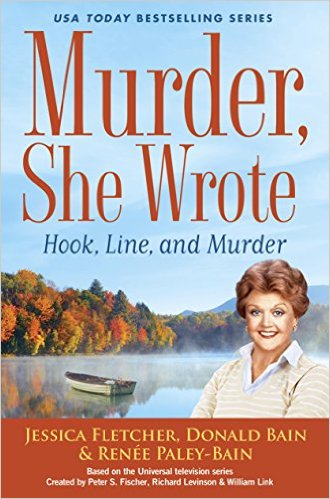 Hook, Line, and Murder by Donald Bain - Coming in October 2016.
Hook, Line, and Murder by Donald Bain - Coming in October 2016.
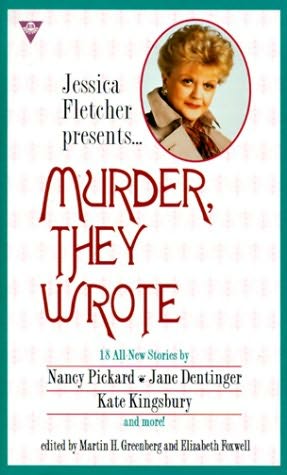 Murder, They Wrote edited by Elizabeth Foxwell and Martin H. Greenberg - These books are an interesting concept - each is a collection of short stories written by female authors in the mystery field. There's just one flaw - hardly any of the contributions have anything to do with the show. When I bought the first book, the show had been off the air for, oh, about six months, and already I was beginning to starve for new material. I was disappointed to find that in that entire book, only one - one! - story was about Jessica; all the others had absolutely nothing to do with MSW. An entire volume of bookend episodes!
Murder, They Wrote edited by Elizabeth Foxwell and Martin H. Greenberg - These books are an interesting concept - each is a collection of short stories written by female authors in the mystery field. There's just one flaw - hardly any of the contributions have anything to do with the show. When I bought the first book, the show had been off the air for, oh, about six months, and already I was beginning to starve for new material. I was disappointed to find that in that entire book, only one - one! - story was about Jessica; all the others had absolutely nothing to do with MSW. An entire volume of bookend episodes!
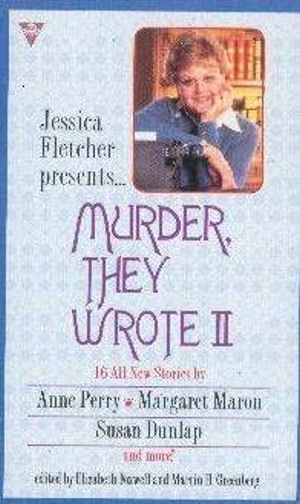 Book Two (Murder, They Wrote II) is more of the same, but does include a couple of very clever MSW parodies.
Book Two (Murder, They Wrote II) is more of the same, but does include a couple of very clever MSW parodies.
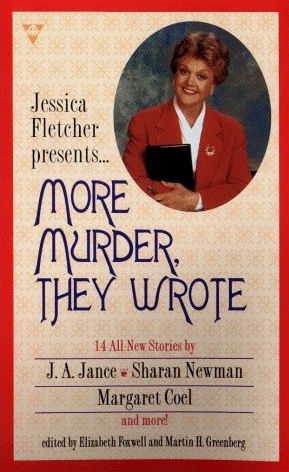 Book Three, (More Murder, They Wrote) which admittedly I haven't gotten completely through yet, doesn't seem to have any connections to the show at all.
Once I got over my disappointment that these books are connected to MSW in name only, I did find that all of the stories are quite good - each one a perfect read for right before bed, or during lunch. These are all very good writers, and their stories are well worth reading - I just wish they were writing about Jessica!
Book Three, (More Murder, They Wrote) which admittedly I haven't gotten completely through yet, doesn't seem to have any connections to the show at all.
Once I got over my disappointment that these books are connected to MSW in name only, I did find that all of the stories are quite good - each one a perfect read for right before bed, or during lunch. These are all very good writers, and their stories are well worth reading - I just wish they were writing about Jessica!
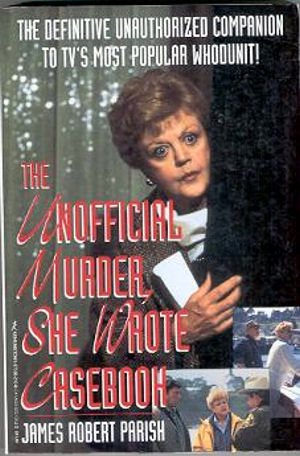 The Unofficial Guide to Murder, She Wrote by James Robert Parish – Who cares if it’s unauthorized? This book rocks! Its main function is as a compendium of Murder, She Wrote episodes, providing concise plot summaries without giving away the identity of the killers. Also provided are highlights and trivia from each episode, a nifty photo section, and a history of the evolution of the series from its first season under Peter S. Fisher to its final one under Angela Lansbury herself. There are occasional factual errors, but they are rare. A must have handbook for devoted fans and novice viewers alike.
The Unofficial Guide to Murder, She Wrote by James Robert Parish – Who cares if it’s unauthorized? This book rocks! Its main function is as a compendium of Murder, She Wrote episodes, providing concise plot summaries without giving away the identity of the killers. Also provided are highlights and trivia from each episode, a nifty photo section, and a history of the evolution of the series from its first season under Peter S. Fisher to its final one under Angela Lansbury herself. There are occasional factual errors, but they are rare. A must have handbook for devoted fans and novice viewers alike.
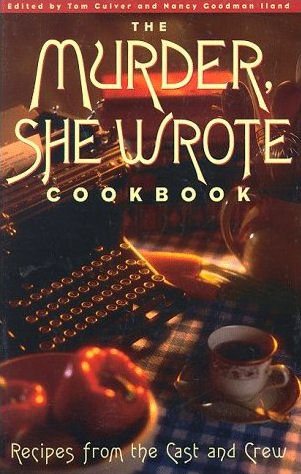 The Murder, She Wrote Cookbook edited by Tom Culver and Nancy Goodman Iland – This book is an interesting collection of favorite recipes of the cast and crew of Murder, She Wrote. Taken together, the cast and crew have and eclectic palate – the recipes are as varied and sound interesting (I haven’t actually tried any yet). Even better than the recipes are the behind-the-scenes glimpses shared by the contributors. Proceeds from the book went to Aid For AIDS, a charity supported by Angela Lansbury (who contributed a wicked good dessert).
The Murder, She Wrote Cookbook edited by Tom Culver and Nancy Goodman Iland – This book is an interesting collection of favorite recipes of the cast and crew of Murder, She Wrote. Taken together, the cast and crew have and eclectic palate – the recipes are as varied and sound interesting (I haven’t actually tried any yet). Even better than the recipes are the behind-the-scenes glimpses shared by the contributors. Proceeds from the book went to Aid For AIDS, a charity supported by Angela Lansbury (who contributed a wicked good dessert).




 Murder, She Wrote by James Anderson – the book pictured is the hardcover collection of James Anderson’s three Murder, She Wrote novels, which first appeared in 1985. The books, The Murder of Sherlock Holmes, Hooray for Homicide, and Lovers and Other Killers were novelizations of some of the earliest episodes of the series. For the most part, Mr. Anderson is faithful to the plots of those episodes, though he does occasionally stray at critical moments. Case in point, he changes the setting of the climactic scene in The Murder of Sherlock Holmes, moving it inside. Somehow, that scene loses a good deal of its punch without the pool.
Murder, She Wrote by James Anderson – the book pictured is the hardcover collection of James Anderson’s three Murder, She Wrote novels, which first appeared in 1985. The books, The Murder of Sherlock Holmes, Hooray for Homicide, and Lovers and Other Killers were novelizations of some of the earliest episodes of the series. For the most part, Mr. Anderson is faithful to the plots of those episodes, though he does occasionally stray at critical moments. Case in point, he changes the setting of the climactic scene in The Murder of Sherlock Holmes, moving it inside. Somehow, that scene loses a good deal of its punch without the pool.






















































